

Traveling with Dementia: 6 Ways to Know If It Will Work

Traveling with dementia can still be possible
When your older adult has dementia , it doesn’t automatically mean that they can’t travel with you.
But it’s essential to honestly evaluate their symptoms before making a decision.
Even if someone is doing well in their familiar environment and daily routine, that doesn’t necessarily mean travel will go smoothly.
For example, wandering , agitation, or angry outbursts could increase when they’re out of their comfort zone. That’s because routine and being home create feelings of security and comfort. When that familiarity gets interrupted by travel, all bets are off.
Safety is always the top priority, both for your older adult and for you.
We share immediate signs that travel won’t be safe, 6 tips to help you figure out if a trip will be successful, how to safely test if travel will work, and what you can do if travel isn’t possible.
Immediate signs that traveling with dementia isn’t safe
In general, these type of dementia symptoms mean that travel isn’t a safe option for your older adult:
- Later stage dementia
- Frequent disorientation, confusion, or agitation (even in familiar places)
- Getting upset or anxious in crowded or loud environments
- Wanting to go home while on short outings or visits
- Delusional, paranoid , or inappropriate behavior
- Physical or verbal aggression
- Frequent or sudden yelling, screaming, or crying
- Wandering behavior
- Problems managing incontinence
- High risk of falls
- Unstable medical conditions
6 tips for deciding if traveling with dementia will be successful
1. How advanced are your older adult’s dementia symptoms? In the early stages of dementia , a person may still enjoy traveling. As the disease progresses, it might become too overwhelming.
It’s tougher to decide if travel will be a good idea in the middle stages of dementia .
In the middle stage, it’s especially important to be realistic when assessing their abilities and challenges. Symptoms can come and go and may vary widely. It may be best to err on the side of caution.
If someone is in late-stage dementia , travel is usually not recommended.
In the late stage, the person with dementia will likely be easily fatigued and overwhelmed by everyday activities, more vulnerable to illness or infection, or struggling with physical abilities like sitting, eating, or swallowing .
2. How well are you coping with their dementia symptoms? An important consideration that’s often overlooked is how you’re doing.
Traveling with someone with dementia is tough, even for an experienced caregiver. The reality is that you’ll need to manage unexpected situations, challenging behaviors (sometimes in public), lack of sleep, and extra-stressful situations.
If you’re coping well with your older adult’s current dementia symptoms, that’s a good sign.
But if you’re struggling to manage symptoms, feeling overwhelmed and burned out, or if you’re learning to deal with new symptoms, travel probably won’t be a good idea.
Adding to the current stress won’t improve quality of life for either of you, may make their symptoms temporarily worse, and would probably prevent both of you from enjoying the trip.
3. How do they do in crowded, loud, or confusing situations? When you’re out with your older adult, how comfortable are they in public?
If their behavior can become uncontrolled or extreme in places like restaurants, grocery stores, or shopping malls, travel is most likely not a good idea.
Think about their typical reaction to crowded, loud, or busy places. Does being in public settings make them upset, angry, overly tired, anxious, or scared? Or do they get upset when plans change suddenly?
4. Is this trip worth it? Because you can’t predict what will happen, it’s usually a risk to travel with someone who has dementia. Think about how important it is for them to take the trip and whether it’s worth that risk.
For example, a significant family event that will be meaningful and memorable carries more weight than a trip just for fun.
5. Where are you going and how will you get there? Another consideration is your travel destination.
Familiar places, especially those your older adult visited often before they developed dementia, will be easier to adapt to.
It will also be helpful to travel to a place where you can keep changes to their regular daily routine to a minimum.
Also think about how you would get to that location. For example, d riving gives you more flexibility and control.
Air travel is hectic and unpredictable, so it’s typically more difficult. And short, direct flights are always better than long flights or multiple transfers.
6. What support system do you have while traveling and at the destination? Another factor that could influence your decision is how much help you’ll have while traveling and at your destination.
A staycation helps you test their reaction to travel
If you’re on the fence about taking your older adult on a trip, it may help to take a short vacation right in your hometown – a “staycation.”
For example, you could book a few nights at a local hotel, drive around for a few hours before going there, eat all your meals out, and sleep there.
Act like it’s a real vacation, far from home. This test lets you see firsthand how your older adult handles the change in environment and routine.
If their symptoms get significantly worse, you can easily end the test trip and go home.
What to do if travel isn’t possible for someone with dementia
Sometimes travel will be too overwhelming or exhausting for seniors with dementia. If that’s the case for your older adult, it’s best not to push them beyond their limits.
If your older adult can’t travel, technology can help them enjoy a significant event or visit with relatives.
For example, if there’s a family wedding, arrange video chats so they can view the ceremony and talk with relatives. That way they still get to participate in the celebration.
Another thing to remember is that this doesn’t mean you can’t travel.
To allow you to go on a trip and take a much-needed break, consider asking family to take over, hiring in-home caregivers , or arranging a short respite stay in an assisted living community that meets their needs.
Recommended for you:
- Find Local Respite Care to Get a Break From Caregiving
How to Understand and Manage Dementia Behaviors: A Comprehensive Guide
- When They Say No: 8 Ways to Introduce In-Home Care for Seniors
By DailyCaring Editorial Team
- Share Article on:
Related Articles

10 Non-drug Ways to Manage Lewy Body Dementia Symptoms

What Is Lewy Body Dementia? 5 Main Symptoms

14 Ways to Calm Dementia Screaming and Crying

Be first to comment Click here to cancel reply.
Cancel reply.
Check out area events, volunteer opportunities and more with AARP Local.
AARP daily Crossword Puzzle
Hotels with AARP discounts
Life Insurance
AARP Dental Insurance Plans
AARP MEMBERSHIP — $12 FOR YOUR FIRST YEAR WHEN YOU SIGN UP FOR AUTOMATIC RENEWAL
Get instant access to members-only products and hundreds of discounts, a free second membership, and a subscription to AARP the Magazine.
- right_container
Work & Jobs
Social Security
AARP en Español
- Membership & Benefits
- AARP Rewards
- AARP Rewards %{points}%
Conditions & Treatments
Drugs & Supplements
Health Care & Coverage
Health Benefits

Staying Fit
Your Personalized Guide to Fitness

AARP Hearing Center
Ways To Improve Your Hearing

Brain Health Resources
Tools and Explainers on Brain Health

A Retreat For Those Struggling
Scams & Fraud
Personal Finance
Money Benefits

View and Report Scams in Your Area

AARP Foundation Tax-Aide
Free Tax Preparation Assistance

AARP Money Map
Get Your Finances Back on Track

How to Protect What You Collect
Small Business
Age Discrimination

Flexible Work
Freelance Jobs You Can Do From Home

AARP Skills Builder
Online Courses to Boost Your Career

31 Great Ways to Boost Your Career

ON-DEMAND WEBINARS
Tips to Enhance Your Job Search

Get More out of Your Benefits

When to Start Taking Social Security

10 Top Social Security FAQs

Social Security Benefits Calculator

Medicare Made Easy
Original vs. Medicare Advantage

Enrollment Guide
Step-by-Step Tool for First-Timers

Prescription Drugs
9 Biggest Changes Under New Rx Law

Medicare FAQs
Quick Answers to Your Top Questions
Care at Home
Financial & Legal
Life Balance

LONG-TERM CARE
Understanding Basics of LTC Insurance

State Guides
Assistance and Services in Your Area

Prepare to Care Guides
How to Develop a Caregiving Plan

End of Life
How to Cope With Grief, Loss
Recently Played
Word & Trivia
Atari® & Retro
Members Only
Staying Sharp
Mobile Apps
More About Games

Right Again! Trivia

Right Again! Trivia – Sports

Atari® Video Games

Throwback Thursday Crossword
Travel Tips
Vacation Ideas
Destinations
Travel Benefits

Beach vacation ideas
Vacations for Sun and Fun

Plan Ahead for Tourist Taxes

AARP City Guide
Discover Seattle

25 Ways to Save on Your Vacation
Entertainment & Style
Family & Relationships
Personal Tech
Home & Living
Celebrities
Beauty & Style

TV for Grownups
Best Reality TV Shows for Grownups

Robert De Niro Reflects on His Life

Looking Back
50 World Changers Turning 50

Sex & Dating
Spice Up Your Love Life

Navigate All Kinds of Connections

Life & Home
Couple Creates Their Forever Home

Store Medical Records on Your Phone?

Maximize the Life of Your Phone Battery

Virtual Community Center
Join Free Tech Help Events

Create a Hygge Haven

Soups to Comfort Your Soul

Your Ultimate Guide to Mulching
Driver Safety
Maintenance & Safety
Trends & Technology

AARP Smart Guide
How to Keep Your Car Running

We Need To Talk
Assess Your Loved One's Driving Skills

AARP Smart Driver Course

Building Resilience in Difficult Times

Tips for Finding Your Calm

Weight Loss After 50 Challenge

Cautionary Tales of Today's Biggest Scams

7 Top Podcasts for Armchair Travelers

Jean Chatzky: ‘Closing the Savings Gap’

Quick Digest of Today's Top News

AARP Top Tips for Navigating Life

Get Moving With Our Workout Series
You are now leaving AARP.org and going to a website that is not operated by AARP. A different privacy policy and terms of service will apply.
Go to Series Main Page
12 Tips for Traveling With a Loved One Who Has Dementia
A daughter plans a family vacation with her dad’s alzheimer’s in mind.
Barbara Barrielle,

When I suggested to my family that we to go to Florida’s Sanibel and Captiva Islands last December, they jumped at the idea. My parents, who are both in their mid-80s, had spent a few weeks on Sanibel each winter for about 10 years, so it was familiar. And it seemed like an ideal destination for a relaxing trip, where we could be joined by my sisters — Tricia, who lives in Columbus, Ohio, and Jennie, who’s based in Raleigh, North Carolina. There are hundreds of condos stretched along the islands’ shell-packed beaches, but nothing feels crowded. Tennis, water sports, beach walking and reading by the shore are the primary activities between eating and drinking. I’d join them from my home in Northern California.
Three years ago, when my father was diagnosed with dementia , we started taking my mother away from their Bay Village, Ohio, home for a short annual break from caregiving for my dad. She loved seeing Hamilton in New York, then enjoyed Charleston and its Southern charm and fabulous food the next year. This year, we thought, we would bring Dad; maybe it would bring back memories, and he would feel comfortable in a place he once loved.

AARP Membership — $12 for your first year when you sign up for Automatic Renewal
By now my father’s cognitive decline was full-blown Alzheimer’s; his increasing memory loss meant his disease was progressing rapidly. But my father was still quite mobile, and his doctor wasn’t concerned about his flying to join us on vacation. And Dad seemed to like the idea when we explained it — repeatedly, due to his memory loss. I grabbed the calendar he checked several times a day and filled it with notations like “two weeks till Sanibel” and “beach coming soon.” He seemed to understand that we were going to one of his favorite haunts.
The day finally arrived. Except for the brisk removal of a mask that sent my dad’s $7,000 hearing aids flying across the airport floor, everyone arrived with little incident (my mom and sister were both on hand to assist him), and we settled in. As we soon found out, the best place to be was at our condo on the beach. We had a handful of meals at restaurants but mostly cooked our own, and those meals turned out better than the food we could find at local tourist spots.

Dementia Caregiver's Guide
The latest advice and resources to help you and your loved ones navigate a diagnosis.
Real stories, resources, and advice
There were disappointments, though. Dad did not really want to walk on the beach and needed to use the restroom frequently. And while we had hopes that his memory cloud might lift during this getaway, they were dashed every morning when he woke up and asked where he was (the first of dozens of times throughout the day). Except for two hilarious nights when he was as clear and funny as he used to be, we spent a lot of time answering his endless questions and trying to keep him engaged.
Traveling? Pack these documents
Before you depart, make sure you have the following items for your loved one:
- Doctors’ names and contact information
- A list of current medications and dosages
- A list of food or drug allergies
- Names and contact information of friends and family members to call in case of an emergency
- Health insurance information
Source: The Alzheimer’s Association
It helped to maintain a sense of humor. One day he woke up and announced that he knew why he was in Florida: “I’m a travel writer, and I am here to do a story on this place,” he declared to my mother, who surely did not keep a straight face.
The bottom line is that it was not the idyllic family vacation we’d hoped for, but it was, nevertheless, fantastic to be together, read on the beach, cook crazy meals and spend time with Dad. He seemed to enjoy himself, at least sometimes; he was more talkative than he is at home, and he reminisced about the trip a bit for a few weeks after returning home.
And we learned a few things. For one, next time we will bring Dad’s dog, Arnie — his touchstone, his pal, his responsibility. He needs my mother in sight at all times, too, but Arnie can be the dam that holds back his moments of panic. We also need to keep sports magazines on hand as a diversion and bring loads of patience.

AARP NEWSLETTERS

%{ newsLetterPromoText }%
%{ description }%
Privacy Policy
ARTICLE CONTINUES AFTER ADVERTISEMENT
A few more tips for traveling with a relative who has dementia:
1. Strategize. Before you go, think about the problems that might arise and how you’d handle them. For our family, that meant having one sister travel on the plane with my parents, in case my mom needed help navigating with my dad, and my arriving before them to be sure the condo was equipped with food and drinks when they got there.
Holland America Line
Up to $200 onboard credit on select cruises
2. Stay relatively close to home. This will decrease time in transit, which can be stressful for someone with dementia. Our trip certainly would have been easier if it hadn’t required flying or an extremely long drive.
3. Explain the plan to your loved one. Well before the trip, begin describing where you will be going and what you may do, even if you need to repeat it often.
4. Try to stick with the familiar. Having beloved, comforting people and pets on hand is key. In our case, that was my mother. We should have brought my father’s dog as well, because he looked for little Arnie every day. And we chose to go to a location my parents had been to many times.
5. Manage expectations. Your loved one may not be as thrilled by the trip as you hoped they would be. My father sometimes said he wanted to be home.
6. Allow for lots of downtime. Don’t overschedule or overstimulate.
7. Try to schedule travel and activities at a time of day when the memory-affected family member is most aware and less prone to panic.

AARP Membership — Memorial Day Sale
LIMITED TIME OFFER. Join AARP for just $9 per year when you sign up for a 5-year term. Join now and get a FREE GIFT!
8. Pack smart. Whether you fly or drive, pack a bag with all of your loved one’s medications, games to play and a smartphone or iPad for entertainment. Make sure you bring any relevant medical information and insurance cards, know where hospital facilities are located at your destination, and have a backup plan and travel insurance in case there is a need to cancel. You may want to give your loved one an ID bracelet if wandering is an issue.
9. If you’re flying, arrive at the airport extra early. Before your trip, you can contact the TSA helpline, TSA Cares, toll free at 1-855-787-2227, or email [email protected] to request extra assistance during the screening process.
10. Keep plans flexible. Don’t hesitate to cancel if you or your loved one’s doctor determines that travel will be overwhelming or medically risky.
11. Be patient. You may hear stories you have heard hundreds of times and need to repeat yourself frequently. Go with the flow.
12. Focus on spending quality time with each other: talking, telling stories, joking and sharing meals, not seeing the sights or having adventures. Those personal moments were the highlights of our trip and the memories we most value.
Potential health benefits of travel
A paper published in June 2022 in the journal Progress in Tourism Management explores how travel could benefit those living with dementia. The team of Australian researchers report that some of the varied experiences that come with travel — sightseeing, dining out and enhanced physical activity — can provide cognitive, sensory and social stimulation that could have some real health benefits for people living with dementia.
“And then there’s the basics, like fresh air and sunshine increasing vitamin D and serotonin levels,” lead researcher Jun Wen explained in a statement. “Everything that comes together to represent a holistic tourism experience makes it easy to see how patients with dementia may benefit from tourism as an intervention.”
It’s important to recognize that not everyone with dementia can travel. In this instance, virtual reality tours may also provide therapeutic benefits.
Editor’s note: This story, first published Aug. 5, 2021, has been updated to include information from a new study.
Barbara Barrielle is a travel and wine writer who also produces films. Her documentary “Crushed: Climate Change and the Wine Country Fires” is at film festivals now.
Discover AARP Members Only Access
Already a Member? Login

More on Dementia

How Therapeutic Fibbing and Diversion Can Help Loved Ones with Dementia and Alzheimer’s
Tactics to comfort, alleviate stress and meet individuals in ‘their reality’

Why Caregivers Should Confront Rather Than Avoid a Dementia Diagnosis
Don’t let fear prevent you from taking steps that may help your loved one

6 Ways to Prevent Someone With Dementia From Getting Lost
Steps family caregivers can take to keep loved ones safe
AARP VALUE &
MEMBER BENEFITS

Hurtigruten Expeditions
5% off cruise fares and a €100 per person onboard credit

AARP Vacation Ideas
Ideas for every type of trip – from cruises to road trips

AARP Travel Center Powered by Expedia: Car Rentals
Up to 30% off select car rentals

AARP® Staying Sharp®
Activities, recipes, challenges and more with full access to AARP Staying Sharp®
SAVE MONEY WITH THESE LIMITED-TIME OFFERS
- Start Your Own Fundraiser
- Find a Community Fundraiser
- Shop at AFA
- Other Ways To Donate

Alzheimer's Foundation of America
Tips for traveling with dementia.

Whether taking a short trip to see friends and family or traveling farther for vacation, it is important to consider the difficulties and benefits of travel for a person with dementia. In the early stages of dementia, a person may still enjoy traveling. As the disease progresses, travel may become too overwhelming. It is imperative to discuss any travel with the individual’s physician to evaluate whether or not travel is recommended or safe.
If the individual’s doctor feels travel is permissible, consider the individual’s abilities, and safety when choosing how and where to travel, including:
- Go with the option that provides the most comfort and least anxiety.
- Stick with the familiar. Travel to known destinations that involve as few changes in daily routine as possible. Try to visit places that were familiar before the onset of dementia.
- Keep in mind that there may come a time when traveling is too disorienting or stressful for the person with dementia.
Other considerations:
- Advise airlines, hotels, or tour operators that you’re traveling with a person who has memory impairment. Provide some examples of your safety concerns and special needs.
- Prepare identification items for your traveling companion including an identification bracelet or clothing tag with their full name and your name. Take important health-and legal-related documentation as well.
- Time your travel. If the person with dementia travels better at a specific time of the day, you may want to make plans accordingly. Take breaks along the way for snacks.
- Allow extra time. Avoid the temptation to cram several activities into one day. You and the person may need more time in between activities to relax and rest. Instead, plan for a single activity and have a couple of alternatives in mind if you end up with extra time.
- Maintain daily routines, including sleep and eating schedules.
Have faith in your own knowledge, judgment and experience. No one knows the individual better than you do. While a growing number of hotel and tour operators have oriented their employees in dealing with persons with dementia, you best understand what works and what doesn’t. Have confidence in your abilities and enjoy your special time together.
Have questions or need more information? Contact AFA’s Helpline at 866-232-8484 or click the chat icon in the lower right hand corner of this page.
View additional fact sheets & information .
Click to enlarge text
Traveling & Dementia: Tips to know before you go
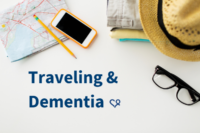
What are the potential benefits of traveling with someone with dementia? A trip can bring physical, mental, and emotional benefits for someone living with dementia. Physically, there’s ability to get outside and increase vitamin D intake. Mentally, the novelty of new experiences like different daily activities, new sights, foods, or smells, are cognitively stimulating and good for the brain. Emotionally, a change of scenery can restore a sense of normalcy, spark new topics of conversation, and forge new connections between the person living with dementia and their care partner through shared experiences. A getaway can also be a form of self-care for everyone involved.
What are the potential risks of traveling with someone with dementia? A change in routine can also be stressful for someone living with dementia, and could result in irritability and confusion. Wandering is also a critical risk to consider. At least 60% of people with dementia will wander at some point. The danger of this increases in an unfamiliar environment. As a care partner, you may not have access to the same resources to find someone who is lost as you would at home. For the person with memory loss, it can be scarier and more difficult to reorient in a new place. If they have wandered or gotten lost before, that may be a sign they should no longer be traveling.
RELATED | Wandering & Alzheimer’s: One program can make a difference
What are general best practices when traveling with someone with dementia? At Alzheimer’s San Diego, we recommend doing the following:
- Travel during a time of day that the person with dementia is most alert or content.
- If that’s not possible, travel during off-peak times to avoid crowds.
- Plan for rest times each day throughout the travel. A realistic itinerary should factor in that both the person with memory loss and their care partner may need more rest/recovery time than usual.
- Pack items that will bring the person with dementia some comfort, such as pictures of loved ones, their favorite music, and tactile items.
- Pack an extra set of clothes, along with incontinence items.
- Inform other entities ahead of time that you are traveling with a person who has dementia. If you’re flying, contact TSA and the airline; if you’re staying at a hotel, let the staff know. As previously mentioned, wandering can happen at any time, especially if a person is feeling uncomfortable. The more people around them who are aware of this, the safer they will be.
- Keep your normal routine as much as possible, starting and ending the day around the same times as you would at home.
- Take a picture of the person living with dementia each morning. If they wander, you will be able to show first responders exactly what they were wearing and what they look like.
- Enroll in the MedicAlert national registry if traveling outside of San Diego County. If you’re traveling within the county, be sure you’re enrolled in the Take Me Home registry .
- Consider other forms of identification: sewing labels into clothing, wallet cards, ID tags that attach to shoes, etc.
- Bring a back-up of important items like eyeglasses in case they are lost.
- Make sure you have key numbers saved in your cellphone, such as doctors, family/friends you can count on in an emergency, or even Alzheimer’s San Diego (858.492.4400).
- As a care partner, don’t forget your own self-care needs: essential medications, comfort items, and the need for respite. Consider taking someone else on the trip with you to share in caregiving duties to avoid feeling overwhelmed.
RELATED | Join a Support & Discussion Group
What are the signs someone living with dementia should no longer travel? At a certain point in the disease progression, it will no longer be safe for someone with dementia to travel. Warning signs include:
- The tendency to wander – this is so important to watch out for!
- Becoming overwhelmed in new places and/or around large crowds.
- Becoming fearful whenever the primary care partner is not around.
- Exhibiting extreme changes in behavior when their normal routine is disrupted.
- The care partner is unable to manage all of their person’s daily needs.
There is no one-size-fits-all policy when it comes to dementia care. While this is a general guide, we know every person’s needs and situation is unique. If you have questions about traveling with someone living with dementia, get free support from our dementia experts by calling Alzheimer’s San Diego at 858.492.4400 or emailing [email protected].
SHARE THIS PAGE
Related posts.
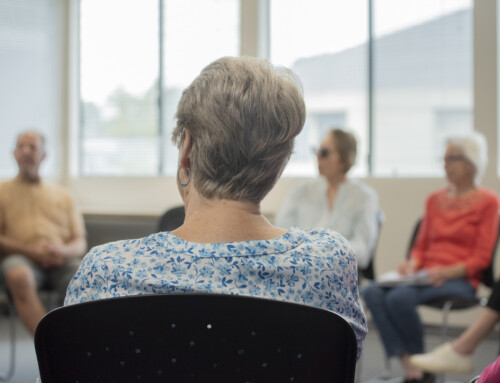
Enfoque de programa: Grupos de apoyo en español en San Diego

HOW TO: Register for Rides4ALZ

CTE & Other Rare Neurological Disorders
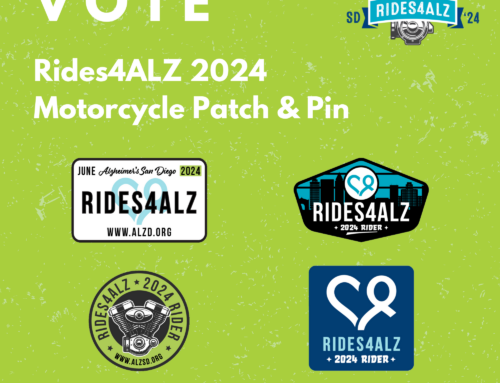
VOTE: Rides4ALZ 2024 Motorcycle Patch & Pin

Meet Braulio Ambriz, our Marketing Coordinator!

How to Prepare for Summer Travel With Someone With Dementia

by Ray Burow | July 11, 2022
Share this article:

This summer, 208 million American adults plan to travel . Some of those folks are probably caregivers, brave souls, traveling with loved ones with cognitive issues.
Taking along a loved one with Alzheimer’s disease or another dementia requires extensive planning. If you’re contemplating a summer road trip or air travel with someone diagnosed with cognitive issues, the following tips may help.
Is it a good idea?
Before booking an airline or planning a road trip, take an honest assessment of your situation. Is the idea realistic? Your loved one’s level of cognitive decline or stage of Alzheimer’s disease determines that.
Barring exceptions to a rule, traveling with an Alzheimer’s patient in the late stages of the disease is impossible. However, a trip together is doable if your loved one is diagnosed with early-onset dementia , is in the early stages of Alzheimer’s, and is in good health and cleared to travel by their physician.

Tau-targeting Treatment Slows Cognitive, Functional Declines: Trial
Mode of travel.
Rather than flying or traveling by train, driving provides a measure of control. It removes the complexities of layovers and delays, which can confuse someone with dementia.
Carefully choose how to travel, remembering that your loved one must have an official photo identification to fly or to travel by train or bus. This can be an issue for elders who no longer drive or those with expired identification. Check with the local Department of Motor Vehicles to learn what documents are required to secure a new ID.
A trip to the DMV is challenging for someone with cognitive issues, so you don’t want to be asked to return for lack of the correct proof of residence or other information. Some states have mobile DMV units that provide convenient access for seniors. Contact the local DMV for one in your area.
In addition to identification, don’t leave home without proof of COVID-19 vaccinations, just in case it’s required during your trip.
You made the decision. Now what?
You take caregiving on the road when vacationing with someone with dementia, so plan accordingly.
- If you decide to travel by air, book direct flights, if possible.
- Incorporate breaks for meals, bathrooms, and stretching when driving.
- If a drive requires multiple days, secure hotel rooms before leaving home.
- Prepare for the unexpected and purchase travel insurance when booking flights, hotels, and rental cars.
Caregiving essentials for traveling
You’ll need the same basic caregiving essentials on vacation that you do at home. Pack incontinence pads and adult diapers. Super absorbent diapers or those designed for overnight are excellent choices for long trips. Also include the following items:
- Rubber gloves
- Absorbent disinfectant wipes
- Easy on-and-off shoes to wear in the car
- Prescription and over-the-counter medications
- Bottled water to stay hydrated
- Healthy snacks
- Roll of paper towels or extra napkins for the glove compartment
- Audiobook or an activity/puzzle book to occupy your loved one
- Sun hat and sunburn protection
- COVID-19 mask
- A battery-operated alarm to sound if your loved one attempts to wander from unfamiliar surroundings
Traveling with someone with dementia is not the easiest experience, but a brief vacation or road trip with an aged parent or spouse in the early stages of Alzheimer’s could be the last you’ll have together.
Proceed with caution, practice patience, and embrace the memories.
Happy summer!
Note: Alzheimer’s News Today is strictly a news and information website about the disease. It does not provide medical advice, diagnosis, or treatment . This content is not intended to be a substitute for professional medical advice, diagnosis, or treatment. Always seek the advice of your physician or other qualified health provider with any questions you may have regarding a medical condition. Never disregard professional medical advice or delay in seeking it because of something you have read on this website. The opinions expressed in this column are not those of Alzheimer’s News Today or its parent company, BioNews, and are intended to spark discussion about issues pertaining to Alzheimer’s disease.
About the Author

Leave a comment
Fill in the required fields to post. Your email address will not be published.
Recent Posts
- BioXcel planning pivotal trial of BXCL501 for Alzheimer’s agitation April 18, 2024
- NK cell therapy seen to slow cognitive decline in Phase 1 trial April 11, 2024
- Facing an Alzheimer’s diagnosis and caregiving is scary, but doable April 8, 2024
- Eisai seeks FDA approval of Leqembi IV maintenance dosing April 4, 2024
- Voyager’s tau-reducing therapies show promise in preclinical studies March 28, 2024
Recommended reading

NK cell therapy seen to slow cognitive decline in Phase 1 trial

Facing an Alzheimer’s diagnosis and caregiving is scary, but doable

Eisai seeks FDA approval of Leqembi IV maintenance dosing
Subscribe to our newsletter.
Get regular updates to your inbox.
What It’s Really Like to Travel With Alzheimer’s
By Cassie Shortsleeve
For those who love to explore the world , a diagnosis of memory loss can be devastating—and interpreted as a sentence to stay home. Yes, travel isn't for everyone with Mild Cognitive Impairment (MCI), a memory issue that often leads to Alzheimer’s, or Alzheimer’s itself, especially in the disease’s later stages, when overstimulation can contribute to stress, anxiety, and confusion. But for many people for whom travel is an integral part of life, continuing to do just that can be a means to keep up normalcy—and maintain their passions and hobbies.
“To be a good traveler, you have to be curious,” says 70-year-old Carol Poole, who was diagnosed with probable Alzheimer's five years ago and who has since spent time in Thailand and Cambodia, and just returned from Abacos, in the Bahamas, by boat. “I am that.”
Curiosity benefits the brain, too. “From a general brain health perspective, anything that is stimulating to the mind is generally good,” says Ronald Petersen, M.D., Ph.D., director of the Mayo Clinic’s Alzheimer's Disease Research Center . The “what” of that stimulation varies by person, of course, but visiting museums , learning new cultures, or trying new foods can—for those who enjoy those activities—maximize quality of life. “Mental stimulation is thought to be beneficial for thwarting off the rapid progression of the disease," he says.
For Poole, who used to travel solo but now more frequently goes on trips with her husband and children, travel is just that. “New places and experiences are pleasant challenges for my mind," she says.
Like they do for anyone who travels, trips vary in scope and size for people with Alzheimer's or MCI.
This fall, 75-year-old Darrell Foss of Eagan, Minnesota, will paddle throughout Canada's Maritime region on a guided group trip. Foss was diagnosed with MCI in 2015. “My whitewater trips have come to an end—I just can’t think fast enough to paddle whitewater—but the water is still very relaxing to me,” says the retired CPA and adjunct college professor. Foss and his wife, Mary, have traveled extensively internationally— Paris , Madrid, Gibraltar, and all over Switzerland—since his diagnosis. Mary says she thinks talking about photos they take (churches in Barcelona , the Great Wall) and interacting with new people they meet on their travels help maintain her husband’s mind. Darrell agrees.
But the question lingers: Despite the benefits, why travel if there’s a chance that someday, you might not remember your trip at all?
“It’s the joy of being there. I live in the moment. I do what I need to do and what I want to do every single day,” says 63-year-old Pam Montana of Danville, California, who was diagnosed with early-onset Alzheimer’s. A longtime Intel exec, Montana found that visiting company factories in China, Japan , Manila, and Malaysia kickstarted a love of travel years ago. Montana has booked her fourth trip to Florence for the end of the summer.
“Even if I'm not able to remember where we ate a meal, I don’t know if I will forget the experience and the joy of being with friends or getting a first-class upgrade ,” she says. Keeping a detailed journal also helps Montana re-experience what it was like to be in a place: the feelings, the foods, the fun. She recently found one from 15 years ago. “I wrote down every drink we had, every restaurant we went to, every meal we ate. I read every word. It was so wonderful,” she says.
Making memories also matters for other people, says Poole, whose two sons have developed her love of travel: “Even though I won’t remember, when we get to those nasty bits at the end, I am leaving a legacy of travel adventure memories, made with those I love.” For travel closer to home, Poole's husband has also built her a tiki bar in their backyard; an oasis when they can no longer travel, meant to replicate the Caribbean islands (she's been to most of them).
Of course, traveling with MCI or Alzheimer's requires accommodations, and anyone who does so should plan extensively, communicate with their doctor, and go with the appropriate support—think a guided small group (Darrell and Mary use EF Go Ahead Tours ) or an identification bracelet with the person’s name and relevant phone numbers on it, in the event of separation. Poole, Foss, and Montana have all, in large part, delegated planning duties, including making reservations and booking hotels , to their partners. The Alzheimer’s Association also notes it's important to alert hotels and airlines of any specific needs, and to have a bag of essentials on hand (including snacks, water, and a travel itinerary ).
But an Alzheimer’s diagnosis can also lead to other changes in the way people travel. Montana and her husband, for example, used to compromise— sure, we can go there ; okay, it's your turn to choose —but now, most decisions lean in her favor. "We make conscious decisions about where we’re going, who we’re going to go with, and how long we’re going to stay there, and I have full veto power," she says.
Adopting a more leisurely pace ( lingering in Tuscany a few days longer before heading back to the city, taking a flight that doesn't require you to wake up with the sun) is essential, too. Time zone changes, higher altitudes , or dehydration can bother anyone , but with brain dysfunction, symptoms can crop up more rapidly, Petersen notes.
But, within the right constructs, for someone who wants to continue seeing the world and be reminded of where they've been, there’s a case to be made for the now. You'll enjoy travel more when your brain is functioning the best that it can, which—for people with MCI or Alzheimer's—is sooner than later. “Life continues on,” says Mary Foss. “It doesn’t stop because you have a disease. We live our life the way we have in the past, with some added changes. You just have to keep on moving.”
June is Alzheimer’s and Brain Awareness Month. The Alzheimer’s Association provides many resources on how to travel safely with the disease.
By signing up you agree to our User Agreement (including the class action waiver and arbitration provisions ), our Privacy Policy & Cookie Statement and to receive marketing and account-related emails from Traveller. You can unsubscribe at any time. This site is protected by reCAPTCHA and the Google Privacy Policy and Terms of Service apply.

Enter a Search Term
On the road: travelling with someone with alzheimer’s.
Senior Care Management Services, LLC
- Expert Advice
Learn some helpful tips from an expert on creating a safe and smooth journey with someone who has Alzheimer's.
Have you ever thought about travelling long distance with a loved one with Alzheimer’s and struggled with how to manage the travel details, the drive, and keep your loved one safe? Here we will take a look at doing just this - driving long distance with someone with Alzheimer’s, and provide helpful suggestions from a travel nurse who works specifically with the elderly.
Cindy Shaeffer, M.S., R.N., A.P.N., and flight nurse with Travel Care & Logistics, Inc. of Chicago, makes her living travelling with older adults. Hired by families to assist them in getting an elder from one place to the next, sometimes by land, sometimes by air, she provided some suggestions for families to use for a smooth journey:
- Travel early in the morning;
- Avoid situations with lots of people or lots of noise;
- Travelling via car means there should be three people in the car: the driver, the person with Alzheimer’s and the third person watching the one with Alzheimer’s—at all times;
- Depending on the distance and cost of air travel in the area of travel, hiring a car service can be a better and less expensive option.
Documentation and Medications
- Bring medical records in case you need to seek healthcare for your loved one with Alzheimer’s, including a summary of care, list of medications, and Power of Attorney for Health Care;
- Bring your loved one’s valid state ID;
- Bring two sets of medications—the primary set in a pill minder, and a backup in original bottles because the bottles have the instructions.
Some Things to Remember
- Keep your loved one’s physician informed of your travels plans—in case he needs to be contacted while you are travelling;
- When travelling, remember frequent small meals, and frequent small amounts of fluids.
You’ve Arrived. Making the Setting Alzheimer’s Friendly
When arranging for overnight accommodations, Ms. Schaefer suggests considering a stay in a local assisted living facility under a respite stay. An assisted living facility is already designed for the safety of residents, and the staff is trained, so the facility is prepared for someone with Alzheimer’s.
Whether your loved one and the caregiver stay in a hotel or an assisted living facility, be sure to mimic your loved one’s home environment by setting up the queues just like home—i.e. the toothbrush, soap, washcloth, pills. These visual reminders can make it easier for your loved one to accomplish these tasks.
Structure Sleep Time for a Smooth Stay
On each of your days away, including travel days, allow for your loved one to take an hour long nap in the early afternoon, making sure she wakes while the sun is up. Then stay up for the rest of the afternoon, eat dinner, stay up and then go to bed. As confusion can be worse in the evening, this structure will allow your loved one to remain more oriented, and sleep better.
Big Event? Plan Activities and Downtime
If there is a big event during your stay, such as a wedding or family reunion, there is much you can do to provide the structure and the downtime your loved one needs to enjoy the event.
To help your loved one engage in the event, find something he or she can do to participate, making sure to fit it to his or her abilities. It might be folding napkins, organizing silverware, or stuffing envelopes.
Quiet time will be needed during such an event. When things just become too overwhelming, allow for your loved one to retreat to his space with the caregiver. On the day after the event, plan for a quieter day—sleeping in, easing into the day, having a quiet activity with an older relative, or meeting up with small groups of family.
The Road Home
Of course, when returning home, continue to follow all the guidelines of your trip to the event: leave early, avoid big crowds, have a driver and a caregiver in the car, hire a car service if needed, frequent small meals and fluids.
Above all, enjoy your time with your loved one.
- Alzheimer’s Disease Toolkit (Helpful Information to Understand and Manage Alzheimer's Disease)
- Expert Information on Alzheimer's Disease (Articles)
About the author
Kathleen allen, lcsw, c-aswcm.
Kathleen Allen has been working with older adults and their families for over 20 years.
Help find a cure
Donate to help end Alzheimer’s Disease
I would like to donate
Stay in touch.
Receive Alzheimer’s research updates and inspiring stories
AARP Travel Center Blog
- Flight + Hotel
- Things to Do
How to Travel With Someone Who Has Dementia
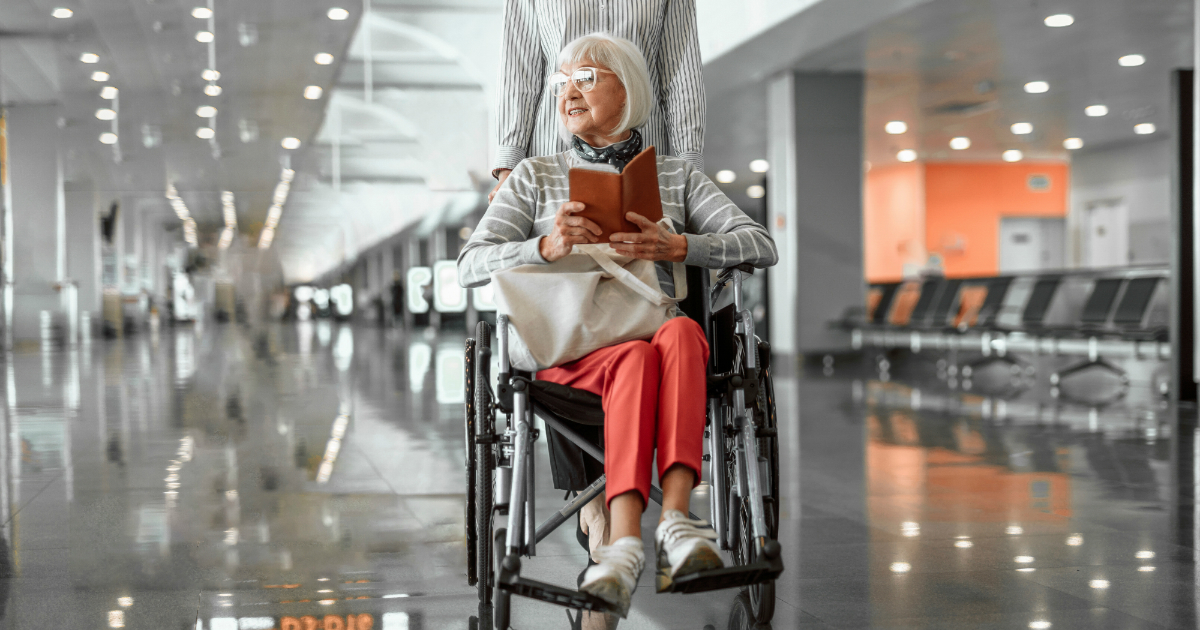
If you are caring for a parent with dementia, chances are, you will want or need to travel together at some point. Maybe you want to return to a favorite family vacation spot or take a trip to visit your siblings.
While traveling with someone with dementia can come with its ups and downs, it is certainly not impossible. It just involves taking a little extra care and thinking ahead. Of course, you’ll want to consider safety risks and medical needs, but you’ll also want to determine the best mode of transportation and avoid possible triggers.
To make your upcoming travels easier, we’ve provided a list of our top 11 tips and tricks for how to travel with someone with dementia.
1. Talk to a doctor
Before planning a trip, make an appointment with your relative’s doctor to get the okay to travel in the first place. The doctor may advise against it for safety reasons or have recommendations on ways to make your travels less stressful.
2. Pick familiar destinations
Next, when deciding on where to travel, it’s best to pick destinations that your relative is most familiar with as not to cause confusion. Oftentimes, the best vacations for dementia patients are those that are within four hours of home. You may also want to choose a place that is close to emergency health centers or pharmacies.
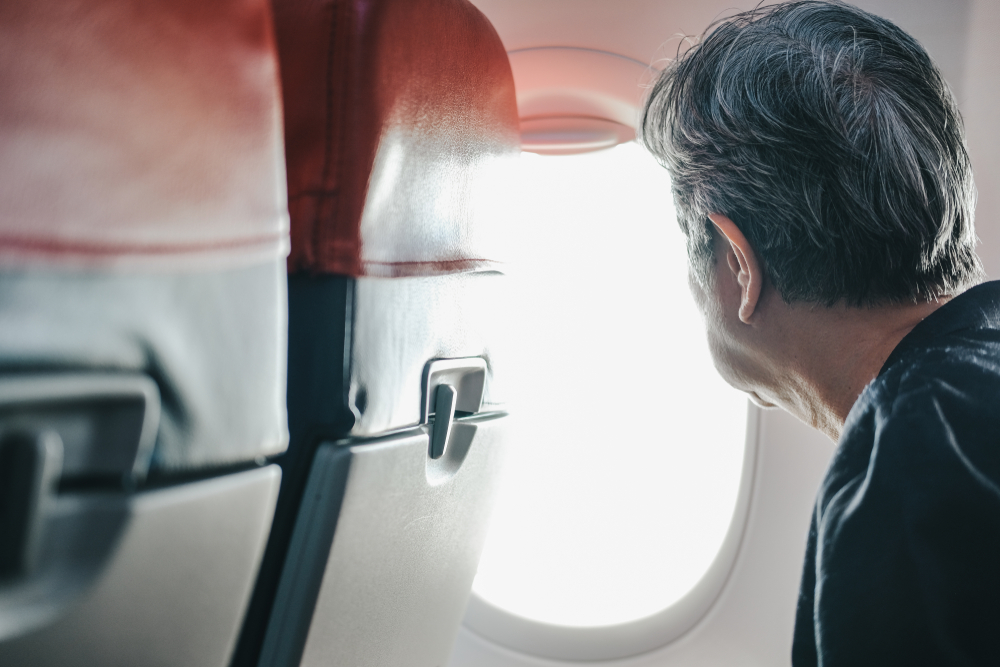
Via 88studio/shutterstock
3. Choose the most direct route
One thing to remember when traveling with someone with dementia is that it is best to get where you need to be as quick as possible. Eliminate unnecessary stress by taking the most direct flight and avoiding connecting flights, layovers, and scenic routes. Would a quick flight be easier than a longer drive? Or would a slightly longer drive be more comfortable for your relative?
4. Provide a medical bracelet
In case you get separated, a medical bracelet can help identify your relative. In addition to providing their medical information on the bracelet, include emergency contact details, too. If they tend to wander, you may want to enroll them in a wandering response service to help get them to safety as soon as possible.
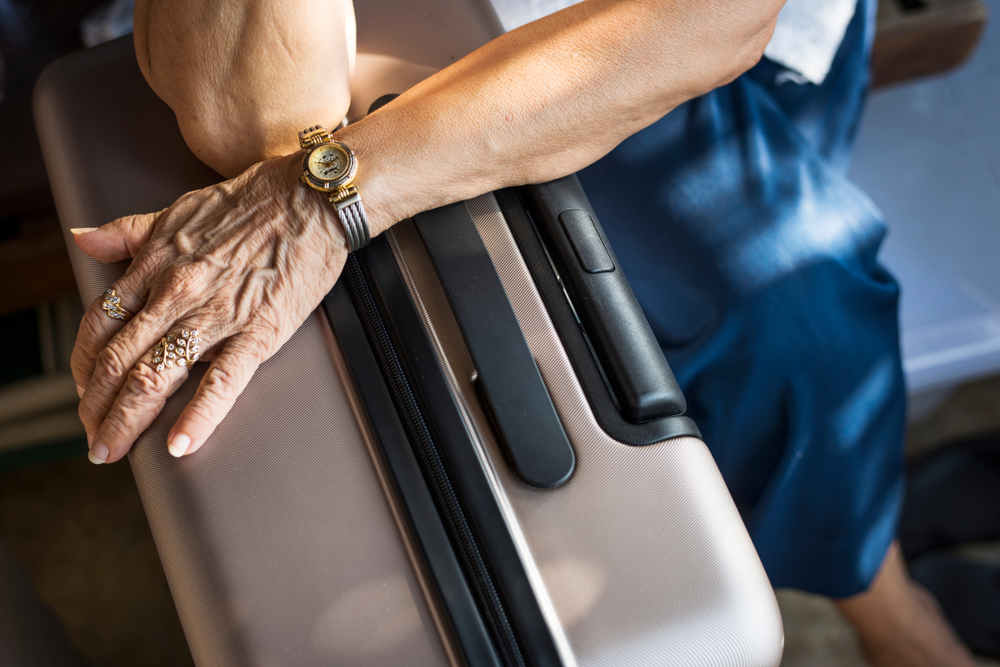
Via Rawpixel.com/shutterstock
5. Pack an emergency carry-on bag
Always keep a bag with essentials on hand. You’ll want to pack medical documents, medicine, and doctor and family contact information. If you’re boarding a flight, use it as your carry-on item. It may also be a good idea to pack an extra pair of clothing and toiletries to avoid any disruption in case your checked luggage gets lost.
6. Look into hotel options
If you plan on staying in a hotel, it’s a good idea to inform the front desk of your relative’s conditions so they can best assist and accommodate you during your stay. When booking your room, request a quiet one on the first floor without sliding glass doors to help prevent any accidents. Some hotels may even provide child-proof doorknobs, in case your relative tends to wander. To make it feel even more comfortable for them, bring along pillows and blankets from home.
7. Consider their tendencies
Is there a time of the day when your relative seems the calmest and most relaxed? If so, it’s a good idea to travel during that time. Also, consider how they react to certain environments. Do loud noises, crowds, or busy places cause agitation? Think ahead and try to avoid any possible triggers.
8. Schedule time for relaxation
Traveling and visiting a new destination can be overwhelming. Be sure to make plenty of time for rest and recuperation. Also, avoid over-packing your itinerary with activities.

Via Monkey Business Images/shutterstock
9. Pack distractions
Bring along games, activities, and photos, which can help distract your relative and make them feel calmer and at ease. Do they have a favorite song that calms them down? Have it on hand to play. If they have hobbies, like puzzles or crosswords, pack those, too.

10. Hire help
Don’t hesitate to ask for help. Look into caregivers, who are willing to travel with you, to give you some relief. Also, check out medical transport services to help you get around. Knowing you have someone to help you may make the vacation more enjoyable for everyone.

Via Olena Yakobchuk/shutterstock
11. Be flexible
As much as you try to plan, some things are out of your control. You cannot always plan on how your relative might feel or react from one day to the next. Know their limits and don’t be afraid to cut the trip short if it’s unsafe or too overwhelming for them.
Just because you have a parent with dementia does not mean you are limited to your own town. When it comes to booking a trip together, follow this advice to make your travels go as smoothly as possible.
Header image via Olena Yakobchuk/shutterstock
About Author
Related articles

6 Ways to Explore San Diego for Free

Virtual Tours: How to Celebrate Pride from Home
- About dementia
- Types of dementia
- Testing and diagnosis
- Treatment and management
- Dementia facts & figures
- Dementia in my family
- How to talk about dementia
- Brain health & prevention
- Living with dementia
- What next? After your diagnosis
- For family, friends and carers
- Mood and behaviour changes
- Staying healthy
- Staying connected
- Care options
- Personal stories
- Later stages and end of life
- Get support
- The National Dementia Helpline
- Counselling
- Post-diagnostic support
- The Dementia Australia Library
- In your language
- Get involved
- Ways to donate
- Fundraise for us
- Corporate partnerships
- Volunteer with Dementia Australia
- Dementia Advocates Program
- Dementia-Friendly Communities
- Participate in dementia research
- For professionals
- Professional development and training
- About Dementia Australia
Travelling with dementia
We didn’t think making our Hawaiian holiday dream a reality was possible, but guidance from our doctor and the counsellor at Dementia Australia helped us prepare. It wasn’t always easy, but it is now one of my fondest memories.
Travel is a great joy, and everyone loves a holiday. If you have dementia, or you’re planning to travel with someone who has dementia, travel becomes more complicated. But it doesn’t have to be impossible. The key is planning and preparation.
It starts with deciding whether travel is the right choice for you.
Deciding whether or not to travel
Dementia can change a person’s thinking, mood and memory. Those are all important things when you’re travelling. Take some time to think about whether going on a journey will be good for you, or more stress than it’s worth.
Travel will be more stressful for someone who:
- becomes upset when their routine or environment changes
- needs a lot of help with everyday activities
- gets disoriented, confused or agitated, even in familiar settings
- often wants to go home when they’re out
- has incontinence problems
- is unable to walk safely or for long distances
- gets angry or anxious when their needs are not met
- has falls, or is at a high risk of falling
- has other medical conditions.
Dementia doesn’t necessarily mean you can’t travel, but if a lot of those points apply to you, you might want to consider a simpler travel plan or another way to find enjoyment.
If you’re unsure if travelling is a good idea, talk to your doctor.
Our travel agent was great. She offered us the professional advice and flexibility that we needed and provided us with easy to read maps and instructions for public transport.
Planning is essential for travellers with dementia. A good plan, which the person with dementia is part of and understands, can reduce a lot of the anxiety and confusion that comes with a change to routine and environment.
Here are some things to consider when planning your holiday. These tips are based on input and discussions with people impacted by dementia.
General tips for travelling with dementia
- Always ask for assistance. People can’t help you if they don’t know there is a problem.
- Use luggage with wheels or a lightweight suitcase.
- Leave the bathroom light on at night.
- Keep the person with dementia informed of where you are going and what you will be doing.
- Keep mealtimes, bedtimes, and medication schedules as regular as possible to help reduce stress and anxiety.
- Have your plans and routine written down so you can refer to them whenever you need to.
- Check the availability of public toilets along your route. In Australia, use toiletmap.gov.au .
- Check toilet blocks for multiple exits. Consider using accessible or family cubicles, where there is more room and you can stay together.
- Don’t forget to enjoy yourself! Make memories and have fun. Take lots of photos and souvenirs and reminisce over them when you return home.
- Keep your sense of humour when things don’t go to plan. Holidays always have highs and lows.
Medical clearance
- Ask your doctor if your travel plans are suitable for your situation.
- Some airlines, cruise ship operators and insurance providers may ask for written medical clearance from your doctor.
- Check whether you can take prescription medications on your trip. You may need to purchase extra medication if you plan to be away for a longer time.
- Pack a first aid kit. Include all medications you may need while you are away. Also include medication that may help with stomach upsets, diarrhoea, urinary tract infections or other temporary problems caused by changes in environment and food.
- Medication packs and dispensers can help you organise and keep track of medication.
- Keep your medication in your carry‑on luggage in case your checked luggage is lost or delayed.
- Bring prescriptions and additional medication. This can be helpful if your medication gets lost, runs out, or if you decide to extend your trip.
- Take a list of all your medications and dosages in case you become unwell.
- A letter from your GP or specialist detailing diagnosis and medications used is a good idea when travelling to countries with stringent drug laws.
- Try a short domestic holiday before doing a longer or international trip.
- Avoid travelling at busy travel seasons like Christmas.
- Allow plenty of time for everything.
- Plan to travel at the time of day when you are usually at your best.
- Book ahead as much as possible.
- Check that accessible accommodation, special assistance and transport options are available.
Communications
- If you’re travelling overseas, explore options for a mobile phone plan with international roaming, and save important contact numbers to your mobile phone.
- Download and practise using messaging apps, so you have quick and easy access to your support networks while you are away.
- Consider using Bluetooth tracking tags in all bags.
Identification
- Ensure you have copies of passports, tickets and itineraries so you have a backup if one gets lost.
- Carry details with you, such as your home address, destination and emergency contacts.
- Mark all the person’s clothing with their name.
- their personal identification
- a medical identification bracelet or other indicator that they have dementia
- the contact details of their caregiver
- the contact details of your holiday accommodation
- a trackable phone or other device.
Travel insurance
- Travel insurance is very important. It can cover losses, damage and some unexpected costs that may occur during your travels.
- Some insurance company guidelines may require you to disclose a dementia diagnosis.
- Be sure to read the policy carefully to ensure it covers exactly what you need.
- Having dementia may mean that you will be declined insurance coverage, possibly face higher premiums, or not be covered for certain risks.
Travelling by air or sea
- Allow time to investigate the best travel insurance for your situation.
- To enable the person with dementia to adjust gradually to time differences, build in flexibility and stopovers.
- When booking flights or cruises, ask for special assistance for the person living with dementia. Special assistance can provide easy passage through all stages of boarding and travel across borders.
- Request seating close to the toilet to avoid long walks. Requesting an aisle seat may also be helpful.
- If possible, check luggage through to your final destination.
- Take a change of clothes on the plane.
- To tune out noise, set up music on a portable player or a mobile phone. Listen using noise-cancelling earphones or headphones.
- Packed snacks may be useful as a diversion.
Travelling by car
- Don’t get in the car if you or anyone else is too stressed for you to drive safely.
- Where possible, engage the safety lock to prevent accidental opening of the door. Take special care when getting out of the car, especially when parking, or near traffic.
- Use your phone or the car for GPS navigation.
Travelling by public transport
- Check train and bus timetables before you leave.
- Buy tickets in advance to avoid dealing with busy train stations and unfamiliar bus routes.
- If travelling by bus, let the driver know where you need to go, so you don’t miss your stop.
Coming home
- Allow a few days to settle back into the routine of things. Make sure you eat well and drink plenty of water.
- Schedule an appointment with your doctor to debrief about the trip, your health and wellbeing.
Useful information and contacts
Smart Traveller : The Australian government’s travel advice service. 1300 555 135 in Australia, +61 2 6261 3305 from overseas
TripAdvisor : a website providing customer reviews and travel related information.
Carers Australia : information and resources for carers. Free call: 1800 242 636, Monday to Friday, 9am – 5pm.
National Dementia Helpline : Dementia Australia’s free, 24/7 information, support and advice service. Free call 1800 100 500.
My mother has dementia, but her life continues to be enriched with fulfilment. We went on a cruise last year that provided us with uninterrupted time, gave me some time to relax and just be there for my mum while our needs were taken care of. It was difficult at times, but so rewarding to have shared this time together.

Explore the Dementia Australia Library's guide to maintaining engagement.
- Share on Facebook
- Share on Twitter

Am Fam Physician. 2022;106(5):online
Original Article: Medical Advice for Commercial Air Travel
Issue Date: October 2021
See additional reader comments at : https://www.aafp.org/afp/2021/1000/p403.html
To the Editor: Drs. Powell-Dunford and Adams noted in their article that many air travelers are adults who may have multiple medical conditions potentially affected by flight. I want to highlight another disease, dementia, that may influence airline travel, is common among older adults, and that primary care physicians are more commonly treating.
Patients with dementia and their caregivers may ask their physician for advice about air travel, although few physicians have received training in this area. 1 The Transportation Security Administration and the U.S. Department of Transportation offer guidance about ways to prepare for checkpoints and assistance that may be available at the airport. 2 , 3 Flight attendants may have limits with which activities they are able to assist, so extra planning around certain functional needs (e.g., toileting, eating), additional preparation before travel, and arranging an accompanying caregiver are often necessary.
Multiple planning documents may be useful or needed. A complete medication list with directions, particularly for longer flights, can be helpful when passing through security checks and if the traveler requires any medical assistance. 1 , 4 A list of emergency contacts, and possibly a copy of advanced directives, should also be available.
Flying may be deliriogenic because of pressure changes, noise, humidity, and time shifts. 4 , 5 For long flights, anticholinergic medications prescribed in anticipation of incontinence may worsen cognition or precipitate delirium. Medications sometimes used to assist with time shifts, such as diphenhydramine (Benadryl), z-drugs, and benzodiazepines, are listed on the American Geriatrics Society Beers Criteria and should be avoided. 6 Alcohol should also be avoided because of possible cognitive effects. Melatonin has limited supporting evidence but may be considered. 4 If significant time shifts for long flights are expected, environmental cues and shifting medication times can assist with adjusting a patient's circadian rhythm. Careful planning, such as seating arrangement, noise reduction, activities, and adjusting sleep schedules before a flight may be necessary. 4
Dementia should not prevent adults from enjoying travel and visiting family and friends. Primary care physicians can advocate for their patients and families by providing trusted guidance, recommendations, and assurance before travel.
Witt L, Rau M. Older travelers. In: Walter LC, Chang A, Chen P, et al., eds. Current Diagnosis & Treatment: Geriatrics . 3rd ed. McGraw-Hill Education; 2021: 651–656.
- Transportation Security Administration. Passenger support. Accessed December 12, 2021. https:/www.tsa.gov/travel/passenger-support
U.S. Department of Transportation. Traveling with a disability. Updated July 14, 2022. Accessed October 18, 2021. https://www.transportation.gov/individuals/aviation-consumer-protection/traveling-disability
Sadlon A, Ensslin A, Freystätter G, et al. Are patients with cognitive impairment fit to fly? Current evidence and practical recommendations. J Travel Med. 2021;28(1) ): taaa123.
McCabe T. ‘Doc, can I fly to Australia?’ A case report and review of delirium following long-haul flight. BJPsych Bull. 2017;41(1):30-32.
2019 American Geriatrics Society Beers Criteria® Update Expert Panel. American Geriatrics Society 2019 updated AGS Beers Criteria® for potentially inappropriate medication use in older adults. J Am Geriatr Soc. 2019;67(4):674-694.
In Reply: I thank Dr. Rosenstein, who makes an important and well-referenced observation about dementia and air travel, for the insightful feedback. In particular, benzodiazepines, cited in the American Geriatrics Society Beers Criteria, should be avoided. 1 Family physicians can play a vital role for their patients when considering the effects of flight on dementia and when performing the mitigation measures described by Dr. Rosenstein.
Email letter submissions to [email protected] . Letters should be fewer than 400 words and limited to six references, one table or figure, and three authors. Letters submitted for publication in AFP must not be submitted to any other publication. Letters may be edited to meet style and space requirements.
This series is coordinated by Kenny Lin, MD, MPH, deputy editor.
Continue Reading

More in AFP
More in pubmed.
Copyright © 2022 by the American Academy of Family Physicians.
This content is owned by the AAFP. A person viewing it online may make one printout of the material and may use that printout only for his or her personal, non-commercial reference. This material may not otherwise be downloaded, copied, printed, stored, transmitted or reproduced in any medium, whether now known or later invented, except as authorized in writing by the AAFP. See permissions for copyright questions and/or permission requests.
Copyright © 2024 American Academy of Family Physicians. All Rights Reserved.
- Best overall
- Best for expensive trips
- Best for exotic trips
- Best for annual plans
How we reviewed travel insurance for seniors
Best travel insurance for seniors of may 2024.
Affiliate links for the products on this page are from partners that compensate us (see our advertiser disclosure with our list of partners for more details). However, our opinions are our own. See how we rate insurance products to write unbiased product reviews.
Reaching your golden years doesn't mean your adventures have to end. In fact, in this stage of life, you'll hopefully have more time and resources to travel. But as a senior citizen, you'll want to ensure you have travel insurance that covers any health-related issues arise while you travel.
Our top picks for the best senior travel insurance
- Best overall: Allianz Travel Insurance
- Best for expensive trips: John Hancock Travel Insurance
- Best for exotic trips: World Nomads Travel Insurance
Best for annual plans: Travel Guard
How we rate the best senior travel insurance companies »
Compare travel insurance for seniors
Your health gets more unpredictable as you age, which makes travel insurance more important for seniors. Unfortunately, it's also more expensive. The best travel insurance for seniors won't have too steep of a price hike compared to rates for younger travelers. It will have high coverage limits for emergency medical coverage, trip cancellations, and and emergency medical evacuation. It's also important that your travel insurance offers pre-existing condition waivers , ideally at no extra cost to the traveler.
Here are our picks for the best travel insurance coverage for seniors in 2024.
Best overall: Allianz
- Check mark icon A check mark. It indicates a confirmation of your intended interaction. Good option for frequent travelers thanks to its annual multi-trip policies
- Check mark icon A check mark. It indicates a confirmation of your intended interaction. Doesn't increase premium for trips longer than 30 days, meaning it could be one of the more affordable options for a long trip
- Check mark icon A check mark. It indicates a confirmation of your intended interaction. Some plans include free coverage for children 17 and under
- Check mark icon A check mark. It indicates a confirmation of your intended interaction. Concierge included with some plans
- con icon Two crossed lines that form an 'X'. Coverage for medical emergency is lower than some competitors' policies
- con icon Two crossed lines that form an 'X'. Plans don't include coverage contact sports and high-altitude activities
- Single and multi-trip plans available
- Trip cancellation and interruption coverage starting at up to $10,000 (higher limits with more expensive plans)
- Preexisting medical condition coverage available with some plans
Allianz Travel Insurance is one of the most widely recognized names in travel insurance, and it stands out as one of the top travel insurance providers for seniors. It offers a wide range of policies covering medical treatments overseas and emergency medical transport.
Allianz also provides options for varying trip lengths. Its annual multi-trip policies , for example, cover any trip you make during your policy period, even if they aren't yet planned, making it an excellent option for seniors who vacation multiple times per year.
Read our Allianz Travel Insurance review here.
Best for expensive trips: John Hancock
- Check mark icon A check mark. It indicates a confirmation of your intended interaction. Offers 3 travel insurance plans
- Check mark icon A check mark. It indicates a confirmation of your intended interaction. Cancel for any reason rider available
- Check mark icon A check mark. It indicates a confirmation of your intended interaction. Affordable travel insurance premiums
- con icon Two crossed lines that form an 'X'. Reviews of claims process are mixed
- con icon Two crossed lines that form an 'X'. Buyers may not get specialty coverage for sports equipment and other high value items
- Trip cancellation for 100% of the trip cost
- Trip interruption insurance for up to 150% of the trip cost
- Emergency medical coverage of up to $250,000 per person
- Medical evacuation coverage of up to $1,000,000
John Hancock Travel Insurance plans for seniors offer some of the best coverage available. It provides generous maximum benefit amounts while still offering affordable prices.
Each plan includes coverages like trip cancellation, emergency accident, and emergency medical, with the option to add benefits like CFAR (cancel for any reason) . Plus, getting a free online quote is a quick and straightforward process.
Read our John Hancock Travel Insurance review here.
Best for exotic trips: World Nomads
- Check mark icon A check mark. It indicates a confirmation of your intended interaction. Coverage for 200+ activities like skiing, surfing, and rock climbing
- Check mark icon A check mark. It indicates a confirmation of your intended interaction. Only two plans to choose from, making it simple to find the right option
- Check mark icon A check mark. It indicates a confirmation of your intended interaction. You can purchase coverage even after your trip has started
- con icon Two crossed lines that form an 'X'. If your trip costs more than $10,000, you may want to choose other insurance because trip protection is capped at up to $10,000 (for the Explorer plan)
- con icon Two crossed lines that form an 'X'. Doesn't offer coverage for travelers older than 70
- con icon Two crossed lines that form an 'X'. No Cancel for Any Reason (CFAR) option
- Coverage for 150+ activities and sports
- 2 plans: Standard and Explorer
- Trip protection for up to $10,000
- Emergency medical insurance of up to $100,000
- Emergency evacuation coverage for up to $500,000
- Coverage to protect your items (up to $3,000)
World Nomads Travel Insurance is a great choice for active senior citizens under 70 who want comprehensive travel insurance. The key difference between World Nomads and many other providers is that it covers 200+ adventurous activities like scuba diving, mountain biking, surfing, skiing, and even bungee jumping. In addition, World Nomads' trip cancellation and emergency medical coverage includes COVID-19-related issues. Many other insurers are excluding that type of coverage now.
For adventurous senior citizens over the age of 70 years, World Nomads suggests working with its partner, TripAssure .
Read our World Nomads Travel Insurance review here.
Trip cancellation coverage for up to 100% of the trip cost and trip interruption coverage for up to 150% of the trip cost
- Check mark icon A check mark. It indicates a confirmation of your intended interaction. Trip cancellation coverage of up to 100% of the cost, for all three plan levels
- Check mark icon A check mark. It indicates a confirmation of your intended interaction. CFAR covers up to 75% of total trip costs (maximum of $112,500 on some plans)
- Check mark icon A check mark. It indicates a confirmation of your intended interaction. Medical coverage of up to $500,000 and evacuation of up to $1,000,000 per person
- Check mark icon A check mark. It indicates a confirmation of your intended interaction. Includes COVID coverage
- Check mark icon A check mark. It indicates a confirmation of your intended interaction. Above average baggage loss and delay benefits
- Check mark icon A check mark. It indicates a confirmation of your intended interaction. High medical evacuation coverage
- con icon Two crossed lines that form an 'X'. Premiums may run slightly higher than competitors
Travel Guard is a well-established and highly rated name in the travel insurance industry. It offers three main coverage options to choose from, and in general its policies have above-average coverage for baggage loss and baggage delays, plus high medical evaluation coverage limits.
- Trip cancellation coverage for up to 100% of the trip cost
- Trip interruption coverage for up to 150% of the trip cost
- Preexisting medical conditions exclusions waiver must be purchased within 15 days of initial trip payment
- Annual travel insurance plan and Pack N' Go plan (for last-minute trips) available
Travel Guard offers comprehensive insurance plans for shorter and longer trips. One of its more unique offerings is its Travel Guard Annual Plan.
This annual travel insurance comes with standard coverage benefits (trip delay, baggage loss, etc.) and substantial coverage amounts, which is important for seniors who travel multiple times per year. Travel Guard also offers a preexisting medical condition waiver, meaning those with certain medical issues can still gain coverage.
Read our AIG Travel Guard Insurance review here.
Understanding travel insurance for seniors
Before diving into the specifics, it's essential to understand what travel insurance is and why it's particularly important for senior travelers. The best travel insurance offers financial protection against unexpected events affecting your trip, such as trip cancellations, medical emergencies, or lost luggage.
Types of coverage
- Medical Coverage: Ensures your medical expenses are covered in case of illness or injury.
- Trip Cancellation/Interruption Coverage: Provides reimbursement if your trip is canceled or cut short due to unforeseen events.
- Baggage Coverage: Covers loss, damage, or theft of personal items during your trip.
Benefits of travel insurance for seniors
- Peace of Mind: Knowing you're covered in case of emergencies can make your travel stress-free.
- Financial Protection: Shields you from potentially overwhelming medical costs and trip cancellations fees.
- Assistance Services: Many plans offer 24/7 assistance services, providing help whenever and wherever you need it.
Making the most of your plan
After choosing a plan, it's crucial to understand your policy fully and know what services are available to you in case of an emergency.
Understanding your policy
- Read the fine print and understand the claims process to avoid surprises.
Emergency assistance services
- Familiarize yourself with the emergency assistance services offered by your plan and keep all necessary contact information handy.
How to pick senior travel insurance
It's wise to compare several different travel insurance policies for the best coverage and pricing, as premiums vary widely between insurers and depend on factors like your age and travel destination.
That said, some of the more essential coverages to look for if you're a senior citizen include:
- Travel medical coverage - This coverage will pay for your medical bills outside the US.
- Medical evacuation coverage - If you're injured or become sick while traveling, this coverage will transport you to the nearest hospital or even back home if your condition necessitates it.
- Preexisting conditions - Coverage for known health conditions. You'll need to purchase travel insurance within a certain time period from when you book your trip to qualify for a preexisting condition waiver .
- Cancel for any reason (CFAR) - The name says it all! It'll cost extra and you'll need to purchase insurance early, but it's the most comprehensive trip cancellation coverage you can get. Note that CFAR insurance usually only covers up to 75% of your trip fees.
- Trip cancellation insurance - This coverage provides reimbursement for your prepaid and nonrefundable costs if you cannot make your trip due to an unforeseen event.
- Baggage delay insurance - This coverage will reimburse you for essentials like toiletries and clothes if your bags are delayed.
- Lost luggage insurance - This coverage will reimburse you up to a specified amount if your bags get lost en route.
Of these, the most critical to note are whether or not your policy covers preexisting conditions and the limits for travel medical insurance and emergency medical evacuation.
Some insurance companies offer a waiver that will cover preexisting conditions. You'll have to follow the requirements for adding a waiver to your policy, like insuring the entire cost of your trip. Or purchase the policy within a specific time after making your first trip deposit payments.
You'll also want to find a policy with high maximum limits for travel medical and emergency medical evacuation coverage. These types of expenses can be substantial, so you want to have appropriate coverage.
When comparing senior travel insurance options, we looked at the following factors to evaluate each travel insurance provider:
- Coverage limits: We looked at each travel insurance company's coverage amounts for benefits like medical emergencies and trip cancellation.
- Flexibility: We looked at how customizable a policy is, so you can choose what your travel insurance policy covers .
- Coverage for preexisting conditions: Preexisting conditions are one of the more critical factors for travel insurance for senior citizens, so we looked at travel insurance companies that offer the best coverage for preexisting conditions.
- Price: We compared travel insurance providers offering reasonable basic and comprehensive coverage rates.
- Benefits geared towards seniors: We compared travel insurance companies that offer solid coverage for senior citizens, like medical evacuation, COVID-19 coverage, and trip cancellation.
You can read more about our insurance rating methodology here.
Seniors should look for travel insurance policies that offer comprehensive medical coverage, including for preexisting conditions and emergency medical evacuation. They should also consider policies with higher coverage limits to ensure adequate protection. Additionally, seniors should seek travel insurance plans that provide 24/7 assistance services, as well as coverage for trip cancellations, interruptions, and baggage protection.
The cost of senior travel insurance coverage can vary depending on your age, overall health, state of residence, travel destination, and length of your trip. However, assuming all other factors are the same, you'll pay more for travel insurance at 70 than at 30.
All travel insurance companies, except World Nomads, included in this guide offer coverage for pre-existing medical conditions as long as you buy your policy within the qualifying period from when you placed your trip deposit.
Allianz is the best travel insurance for seniors due to its wide array of medical coverages and emergency medical transport. Allianz also offers multi-trip insurance policies , which could make sense for seniors who travel frequently.
In some instances, travel insurance companies will have age eligibility restrictions, often only insuring people 80 years old and younger.
Editorial Note: Any opinions, analyses, reviews, or recommendations expressed in this article are the author’s alone, and have not been reviewed, approved, or otherwise endorsed by any card issuer. Read our editorial standards .
Please note: While the offers mentioned above are accurate at the time of publication, they're subject to change at any time and may have changed, or may no longer be available.
**Enrollment required.

- Main content
- Open access
- Published: 29 April 2024
Insights into designing educational materials for persons living with dementia: a focus group study
- Charity M. Hoffman 1 ,
- Sarah E. Vordenberg 1 ,
- Amanda N. Leggett 2 ,
- Esther Akinyemi 3 ,
- Molly Turnwald 1 &
- Donovan T. Maust 1
BMC Geriatrics volume 24 , Article number: 380 ( 2024 ) Cite this article
Metrics details
Persons living with dementia (PLWD) may experience communication difficulties that impact their ability to process written and pictorial information. Patient-facing education may help promote discontinuation of potentially inappropriate medications for older adults without dementia, but it is unclear how to adapt this approach for PLWD. Our objective was to solicit feedback from PLWD and their care partners to gain insights into the design of PLWD-facing deprescribing intervention materials and PLWD-facing education material more broadly.
We conducted 3 successive focus groups with PLWD aged ≥ 50 ( n = 12) and their care partners ( n = 10) between December 2022 and February 2023. Focus groups were recorded and transcripts were analyzed for overarching themes.
We identified 5 key themes: [1] Use images and language consistent with how PLWD perceive themselves; [2] Avoid content that might heighten fear or anxiety; [3] Use straightforward delivery with simple language and images; [4] Direct recipients to additional information; make the next step easy; and [5] Deliver material directly to the PLWD.
PLWD-facing educational material should be addressed directly to PLWD, using plain, non-threatening and accessible language with clean, straightforward formatting.
Peer Review reports
The number of persons living with dementia (PLWD) in the U.S. is projected to grow to 50 million people by 2050 [ 1 ], with 153 million globally by that time [ 2 ]. Most healthcare systems are poorly equipped to serve these patients and address their complex medical and psychosocial needs [ 3 ], reflected by the fact that PLWD have higher rates of emergency department visits and hospital admissions, with higher treatment costs [ 4 , 5 , 6 , 7 ].
One factor contributing to PLWD medical complexity is complicated medication regimens that may lack benefit (e.g., cholinesterase inhibitors), lead to harm (e.g., antipsychotics), or pose adherence challenges (e.g., cognitive impairment, difficulty swallowing) [ 8 , 9 , 10 , 11 ]. The potential for deprescribing—i.e., the intentional de-escalation or discontinuation of a medication in collaboration with a healthcare professional [ 12 ]—has been of growing interest to potentially simplify and improve care for PLWD [ 13 ]. Psychotropic and opioid medication (“Central nervous system [CNS]-active” hereafter) prescribing to PLWD is of particular concern given the associated increased risks of impaired cognition, falls, respiratory suppression, and even death for older adults. Risks are particularly elevated for PLWD who experience CNS-active polypharmacy (3 or more psychotropic and/or opioid medications) [ 14 , 15 ], which is common and considered potentially inappropriate for older adults by the American Geriatrics Society Beers Criteria [ 16 , 17 ].
The EMPOWER study demonstrated that a direct-to-patient educational nudge was an effective intervention to reduce sedative-hypnotic use by older adults without significant cognitive impairment [ 18 ]. Educational nudges include carefully framed information designed to influence behavior without removing patient choice [ 19 , 20 ]. However, existing literature about medication management for PLWD has primarily focused on medication administration by caregivers—as opposed to making decisions about continuing or stopping medications—and interventions have not been co-designed with PLWD or their care partners [ 21 ]. Therefore, we sought to adapt the EMPOWER intervention by collaborating with PLWD and their care partners to develop an educational nudge to encourage PLWD who are prescribed CNS-active polypharmacy to talk with their healthcare professional about the appropriateness of their current medication regimen. Our intervention adaptation was guided by FRAME, which is a guide for adapting and modifying interventions [ 22 ]. We chose to co-produce the intervention materials with participants, by including PLWD and caregiver perspectives and valuing their knowledge during the design process [ 23 ]. This co-production approach was critical because dementia changes cognitive domains including attention, language, and visuospatial abilities (e.g., ability to read and comprehend), which may limit the ability of PLWD to understand complex health-related information and apply it to their own circumstances.
In this article, we discuss lessons learned from a series of focus groups with PLWD and their care partners, which may help inform interventions that include a direct education nudge through written materials. The focus groups were conducted as part of an NIA-funded pilot study of an embedded pragmatic intervention to reduce potentially inappropriate prescribing to PLWD exposed to CNS-active polypharmacy. The overarching goal of the study was to explore whether a direct-to-patient educational nudge co-produced with PLWD and their care partners might increase deprescribing conversations with doctors and ultimately reduce potentially inappropriate medication usage. In this paper, we specifically report on the findings from focus groups conducted with PLWD and their care partners that may help researchers and healthcare systems develop PLWD-facing educational materials.
Study design
This study was developed by a team that included two geriatric psychiatrists, a clinical pharmacist, a social worker, and a gerontologist. We set out to create an informational brochure about the risks associated with CNS-active polypharmacy (i.e., 3 or more psychotropic and/or opioid medications) among PLWD. The initial draft was adapted from the EMPOWER intervention, which addressed sedative-hypnotic prescribing among older adults (without significant cognitive impairment). In addition, while drafting the study brochure, the OPTIMIZE trial [ 24 , 25 , 26 ]—which focused on polypharmacy of 5 or more medications from any therapeutic class specifically among PLWD—was published and available as an alternative model. Our goal was to use feedback from three successive focus groups to iteratively modify the draft of the CNS-active polypharmacy brochure. We wanted to ensure that the content was accessible, useful, and motivated recipients (PLWD and their care partners) to initiate a conversation with their doctor about whether all of their prescribed medications continue to be necessary. Consistent with recommendations from the Dementia Engagement and Empowerment Project (DEEP) [ 27 ], we enlisted care partners (a supportive family member, partner or friend) to join the PLWD in reviewing materials [ 28 ]. In future interventional studies, we plan to deliver written information to PLWD via mail, therefore we provided a copy of the materials via mail ahead of the focus groups.
At least one week prior to the focus group, a copy of the most recent brochure draft was mailed to the participant and his/her care partner. Also included in the mailing was a copy of the consent form and a list of questions to be addressed in the focus group. At the start of the focus group, verbal consent was obtained from each participant. Focus groups took place over video conferencing software (Zoom) and ranged from 60 to 77 min (mean 67 min). Each participant (both the PLWD and care partner) was mailed a $25 check as a thank you for their participation.
Participants and recruitment
Beginning in November 2022, the study team recruited PLWD and care partners from a variety of sources, including: the University of Michigan Health Research website; the National Council for Dementia Minds (NCDM); or a letter sent to patients who were part of the Michigan Alzheimer’s Disease Research Center (MADRC). Eligibility criteria included: (1) age ≥ 50; (2) ability to read and speak in English; (3) dementia of any type, as reported by the PLWD and/or the care partner (i.e., Has a doctor ever diagnosed you with dementia?); and (4) ability and willingness of both PLWD and a care partner to participate in the virtual group discussion. PLWD without a care partner were ineligible to enroll. Recruitment materials informed participants that the research team was seeking to hear the perspectives of PLWD and their care partners as it relates to medications. Information about deprescribing was not included to decrease sampling bias. The research team did not have a pre-existing relationship with participants.
All interested parties completed a brief screening call with a member of the research staff to confirm eligibility; screening calls were completed with the PLWD, their care partner, or both, based on individual comfort.Prospective participants were told that the research team was studying appropriate use of medications in older adults with dementia. During this screening call, participants were asked about their and/or their partner’s gender (PLWD only), age (PLWD only), race/ethnicity and education. One respondent declined to disclose the race of herself and her husband, saying she doesn’t like when people ask about her race. Eligible and interested participants were scheduled for focus groups based on their availability. Focus groups were conducted online to facilitate participation from a geographically dispersed sample. The target number of participants per focus group was 8–12, to include a diversity of perspectives while also ensuring that all participants had an opportunity to speak without feeling overwhelmed or crowded out.
This research was approved by the University of Michigan Institutional Review Board (IRB), which ceded oversight to Advarra, the IRB of Record for the National Institute on Aging’s IMPACT Collaboratory (#Pro00065204).
Interview guide
All team members collaborated to develop a focus group guide to collect information from PLWD and their care partners (See Additional file 1). The guide focused on a few key areas: (1) content (2), graphical presentation, and (3) physical delivery. Each focus group began with a brief overview of the study and an ice-breaker question (e.g., where they were calling from and a favorite seasonal activity) so participants could virtually meet each other.
For the duration of each focus group, we shared images of the brochure on screen to facilitate discussion of specific content and images. We also encouraged participants to refer to the physical copy of the brochure so they could see the version that would be mailed to future participants. We began by examining the cover together, asking what first caught participants’ attention, and what, if anything resonated. We went on to assess participant reactions to the content itself, including specific language. In addition to asking about the length, we obtained suggestions for content to add or remove. Finally, we asked specific questions about sending the brochure, such as: to whom the material should be addressed (e.g., directly to the PLWD or to them and a care partner) and what might increase the likelihood of our unsolicited mail being read rather than discarded. Finally, we asked PLWD/care partner dyads how decisions about their healthcare get made (e.g., who would be involved in a deprescribing decision?).
Brochure design
The initial draft of the brochure was designed by the study team, using the EMPOWER and OPTIMIZE brochures as examples. It was a single page, double-sided, 8-in. × 11-in. three panel brochure printed in color on white cardstock. Findings from each successive focus group informed the next iteration of the brochure (i.e., each set of focus group participants reviewed a slightly modified version). Based on cumulative feedback, the final version of the brochure was created by a graphic designer, in consultation with guidance available online about creating materials for older adults, particularly those with cognitive impairment [ 24 , 25 ]. It was this final version of the brochure that was used on the pilot intervention phase of the research study, which is ongoing (See Additional file 2).
Data collection & analysis
Focus groups were conducted over a HIPAA-approved video-conferencing platform (Zoom) between December 2022 and February 2023. The first author, a trained qualitative social science researcher, facilitated these focus groups; a second author was also present to observe, ask supplementary questions and take notes when schedules permitted (one co-Investigator each at the first and third focus groups). The facilitators had no prior relationship with focus group participants. To refine the brochure for the three successive rounds, we used notes taken during the focus group to identify initial themes for each of the main categories (i.e., content, graphical presentation, and delivery). Following each focus group, the facilitator immediately typed up hand-written notes, which she clustered into themes and key findings and shared with the full study team. These notes and emerging findings were discussed at team meetings and used to inform additional areas to probe. With participants’ consent, the focus groups were recorded and transcribed verbatim by a transcription software embedded in the recording platform. Employing a rapid qualitative analysis method, the study team coded and analyzed these notes, referring back to specific excerpts from the video recordings to provide context or gain further understanding. Points of disagreement among respondents were further explored in subsequent focus groups. Where there remained disagreement among participants, we weighed the tenor of the feedback, as well as the degree of support each side seemed to elicit from other participants. We adhered to Consolidated Criteria for Reporting Qualitative Research (COREQ) guidelines and included them as relevant [ 29 ].
We conducted three focus groups with a total of 22 participants—12 PLWD and 10 care partners. The average number of participants per focus group was 7.3. While having a care partner willing and able to join the focus group was a condition of participation, 2 partners ended up being unable to participate due to health challenges. Each focus group participant was unique; that is, no single participant participated in more than one focus group. Additional information about participants, based on self-report, is presented in Table 1 . At the time of the focus group, two-thirds of the dyads lived in Michigan, while one-third lived elsewhere in the continental U.S.
Five key themes from our respondents are highlighted in the section that follows and summarized in Table 2 .
Theme 1: use images and language consistent with how PLWD perceive themselves
Early drafts of the brochure included a vignette highlighting a sample conversation between a patient and her primary care physician. The vignette was accompanied by a photo of a white woman who appeared to be in her upper 70s, wearing tinted glasses and a polka dot dress, with short gray hair, white pearls, and red lipstick on her pursed lips. Participants had a strong reaction to this image. They felt that the image reinforced stereotypes of dementia patients as being elderly, perceived as old-fashioned or past their prime. As one participant put it (PLWD, female): “I see the stigma. I see what everyone thinks of when they hear the word dementia. And I don’t see any of us on this screen that look like that.” Another participant added that upon seeing that image, “Anyone below a certain age doesn’t even open it [the brochure] up” (PLWD, male).
In both the second and third focus group, there was consensus that there should either be no images of patients, or a diverse set of images, so that viewers from various backgrounds might find someone to identify with, regardless of their race, age, or gender. A participant in FG 2 (PLWD, female) said, “If we’re going to use any pictures, let’s represent all of us young people instead of just the stigma of what people think of when they see dementia or hear dementia.” Another participant (CP, female) added, “[….] On commercials on TV sometimes, you’ll see all different ages and ethnicities and that kind of gets the point across, but you’re limited in space here— and somebody would say, oh you left my group out… But you don’t really need three pictures.”
Relatedly, in a section of the brochure labeled “ Did you know?”— which offered some facts about the escalating risks of overprescribing over time as individuals age—the initial draft drew a distinction between “younger” and “older” adults. The focus group participants included some PLWD in their 50s who did not identify as “older” adults and found this language stigmatizing; they suggested modifying it to be more inclusive. One participant (PLWD, female) said, “We could just say, some people don’t have a problem with the combination of certain drugs, where others do. I think the younger/older part got me.” Rather than singling out older adults, the group instead recommended describing how age can affect the efficacy of certain medications “over time.”
Theme 2: use straightforward delivery with simple language, activities, and design choices
Early versions of the brochure included a brief quiz with true/false items. This element was modeled after the EMPOWER brochure and its approach based on constructivist learning theory [ 18 ], which sought to introduce cognitive dissonance related to recipients’ current prescription medication regimens. However, focus group participants expressed strong negative reactions to this mode of presenting information—for PLWD, the quiz felt like an opportunity to fail. Some said it conjured memories of a pop quiz being delivered in school. Then, in addition to the quiz itself causing anxiety, it was constructed such that the correct response for some items was true, while others were false—which also made interpreting the correct answers confusing. One respondent (CP, male) said:
It seems to me that all the answers should either be all true or all false. Because I could see [my wife, who is a PLWD] or my mother coming to me and saying, ‘I got this brochure,’ and I had to kind of think through which wasn’t true, when the other two were. I think I would just make them all true or all false.
As this participant stated, PLWD may find it difficult to keep track of which responses were true and which were false, and presenting facts as questions could impose unnecessary stress.
In addition to the content being a potential source of confusion, the presentation and layout were, as well. A participant in the second focus group (PLWD, female) reported:
“There’s shapes, and there’s black boxes, and there’s different fonts—there’s bold and there’s different sizes of text. […] When I see this, I almost can’t see anything […]. It’s kind of like, when I’m searching for a can of soup at the market—I don’t do that anymore because I just can’t see… I can’t find it. It’s too overwhelming. […] All of a sudden, I can’t…my brain…my eyeballs cannot find what you want me to find.”
For PLWD, not just the content but also the presentation and layout of the content could contribute to information overload.
Theme 3: avoid content that might heighten fear or anxiety
Participants had strong negative reactions to words or images that conjured fear. The initial draft of the brochure had “You may be at risk” in large letters across the opening panel. While some participants found this message to be an appropriate, engaging opener, the majority were turned off by it. As one participant (PLWD, female) explained:
To me, when I first got it in-in the mail, that ‘You may be at risk’ was a little alarming. […] Every morning I take 8 medicines, and I’m just gobbling all the time. And to me, … for someone with dementia, even an early to moderate case, we already feel at risk. […] [G]et rid of the, ‘You may be at risk,’ […] and take away the scary stuff.
In a subsequent focus group, a participant recommended a “non-alarmist approach,” saying that felt “more respectful.” Another PLWD (female) agreed, saying, “[The] one that…where it just starts out with ‘You may be at risk’- having anxiety, that would set me off. [….] ‘Oh my gosh! I need to get into my doctor right away!’ And then you call your doctor, and you can’t get in for three months. Your anxiety is just going to be off the charts.”
Participants also shared concerns about the image that we initially selected to represent polypharmacy. In the original draft, under the “You may be at risk” text, there was a pile of identical medication capsules with an open pill bottle on its side at the edge of the frame. This was perceived as distressingly off-message for at least one participant, who said she associated that many of the same pills with a suicide attempt (CP, female). Another participant concurred, saying, “It does kind of look like an overdose situation” (CP, male). Instead, the group suggested showing a mix of different pills, which they felt would be a less alarming way to represent their experiences of being prescribed a growing number of medications they were expected to take daily.
Theme 4: direct recipients to additional information; make the next step easy
Participants expressed an eagerness to find and explore further resources about navigating medications and cognitive impairment, though they expressed uncertainty regarding appropriate next steps. One PLWD (male), a retired healthcare professional explained how a diagnosis of dementia compares to more “typical” or better understood ailments:
If […] diabetes is given to you as a diagnosis, suddenly there is put into motion three or four different parts that the doctor will wind up saying to the nurse or front desk,‘I need Mrs. So-and-So to have the diabetes protocol. I need her to have the information about going to the class about how to give herself injections, how to monitor their diabetes for a sliding scale, send her to a nutrition class…’ But I don’t know how you’d do that with dementia.
He suggested including links to websites in the brochure so patients can find additional information. His care partner agreed, saying, “Send us to some websites where we can educate ourselves a little bit.”
Likewise, a participant in the second focus group (PLWD, male) suggested including links to websites rather than phone numbers: “I mean, our kids would, you know—where can I go on the app? Where can I go online?”
Another participant (CP, female) recommended including the clinic’s phone number directly in the brochure, saying, “While you’ve got it in your hand, it’s a good time to call. I know with [my husband] and his dementia, he does things right away, so he doesn’t forget. So if it’s right in his hand […] or our mind, you can call while it’s in your hand. You probably have the number [somewhere], but let me tell you, if I don’t have to look it up, I like you guys a whole lot more.”
To reiterate, participants described a lack of clarity on next steps once they received a dementia diagnosis, and wanted the brochure to include some concrete, tangible next steps.
Theme 5: deliver material directly to the PLWD
Participants recommended mailing materials directly to PLWD in a plain, white envelope. Some reported that gimmicky, attention-grabbing junk mail has become so common that they would prefer a simple, straightforward mailing: hand-addressed if possible, with a return address that includes the health system’s name on the front.
“I’m in the position of tossing out a whole bunch of what I call ‘gimme letters,’ be they wonderful organizations or not,” said one care partner (CP, female).
“You don’t open them,” another participant agreed (PLWD, male). One care partner (male) chimed in that a return address from a reputable source is helpful, while another PLWD (male) added, “You want to play up the thing, this is medical, this is [the University]; this is helpful.”
We also asked whether we should address the materials (i.e., the mailing label) to eligible participants, their care partners, or both. Participants were emphatic that the PLWD should be identified and listed first, regardless of their stage of cognitive impairment. One participant (PLWD, female) said, “It does tick me off when I get left out of something that’s meant for me. Then I immediately go to, ‘I know you think I’m stupid, but don’t treat me like a kindergartener.’” Another care partner (female) agreed, saying:
Leaving him off […] would really piss me off, you know. Definitely, out of respect, it should be addressed to the person involved. […] Now, I will probably be the one to open it and read it to [my husband]; he would just, he’d hand it to me. But I definitely think that the person involved should be on it. Spouses or caretakers, that’s okay as a second, sure. Just respect the patient.
Through three focus groups, we learned a number of lessons that may be applicable to healthcare researchers and clinicians developing patient-facing education materials for PLWD. Perhaps the most important and overarching lesson is to use an approach that does not unintentionally convey assumptions about PLWD’s identity or autonomy. The assumptions can potentially be avoided in two key ways.
First, those developing materials should carefully consider the pros and cons of using visual representations of individuals chosen to represent the intended target audience. These representations may either not, in fact, reflect the actual participants, or the representations may conflict with how participants perceive themselves. As a result, participants may gain a negative first impression of the material that then makes them unlikely to engage with the written content (e.g., “Anyone below a certain age doesn’t even open it up”).
Secondly, both PLWD and care partners were clear that the material should be addressed to the person with cognitive impairment, even if that person might then ask their care partner to lead the decision-making. Ultimately, the focus groups clearly emphasized the importance of the PLWD remaining the explicit target of the information, and in a way that did not reflect societal stereotypes of what an aging person might look like. In addition to substantive feedback on formatting and content choices that would make written materials easier to engage with, our focus group participants also offered additional feedback regarding the tone of materials specifically designed for PLWD. While their initial reactions to materials designed to induce cognitive dissonance were telling, more research is needed to explore the balance between avoiding undue discomfort to a population that already feels vulnerable, while also provoking sufficient concern to motivate a potential behavioral change.
One of the most successful deprescribing interventions—and the basis of our adapted intervention—was EMPOWER, which used constructivist learning theory intended to affect change by introducing cognitive dissonance related to medication use. However, participants in our focus group described this approach as anxiety-inducing and “scary.” Generally, researchers or clinicians do not want to present information deemed scary, yet some degree of dissonance may be necessary to contribute to behavior change. Future work may be needed to understand whether and how theories of behavior change can apply to PLWD. Finally, separate from the PLWD response to the actual content, the visual presentation of the information may also present challenges in a population that is experiencing change in their visuospatial abilities.
This work does have some limitations. We did not gather information about the type, duration, or severity of the dementia, and participants were those who were interested in engaging in a focus group about these educational materials; therefore, our findings may not be generalizable to all dementia severities or subtypes. In addition, PLWD needed to have a care partner willing to participate (a close friend, romantic partner, or family member), and to be willing and able to join a remote, video call. Therefore, those PLWD with more severe disease or more limited social support or access to technology were under-represented. Furthermore, while our small sample size was appropriate for a qualitative exploration, we acknowledge that perspectives may vary by sociodemographic characteristics such as race, ethnicity, income and level of education, which represent an important area for future dementia research [ 30 ]. There was not always consensus among participants; sometimes solving one design problem creates a new one. While we tried to work from a majority model, the nature of a focus group may reward those people more willing to speak publicly and underrepresent the concerns of those who are more reticent to speak. However, the facilitator made efforts to compensate for this by soliciting additional input from quieter participants, explicitly seeking out points of agreement, disagreement, or clarification, and allowing pauses between speakers, rather than immediately launching into the next question. Finally, we offered to provide a final version of the brochure to focus group participants upon request; however, we did not provide a formal process for participants to continue providing additional feedback.
Overall, the feedback from our focus group participants was consistent with best practices recommended by existing scholars of dementia [ 27 , 28 ]: Materials should be concise and avoid jargon. The content should be relevant and accessible. The style and format should be clean and straightforward. Ample white space should be present, with simple, easy-to-read (sans-serif) fonts. One contribution from our audience was the importance of diversifying the face of dementia, with the understanding that dementia does not only befall those stereotyped patients we may conjure in our minds. In fact, while other scholars recommend use of images, and in particular photographs, our respondents said they’d prefer to have no photos rather than photos that fail to capture a diversity of experiences, thereby alienating their potential audience. Best practices also recommend avoiding images liable to misinterpretation—we learned this firsthand with our image of many pills, which some participants said they associated with suicide risk or overdose. This specific feedback would have been impossible to anticipate without speaking to PLWD themselves.
As the Alzheimer’s Society notes in their Tips for Dementia Friendly Documents [ 28 ], however, there is not a single format can meet everyone’s needs. Therefore, they advise getting feedback on people’s experiences with one particular document. The focus groups at the center of this study were an effort to do that. Ultimately, PLWD participating in our focus groups expressed enthusiasm for the opportunity to provide feedback. They welcomed the opportunity to contribute insights that may help researchers and clinicians who are developing PLWD-facing materials. In the end, they wanted to feel seen, heard and included. As the Alzheimer’s Society concludes: “Asking [PLWD] early on about how they like to have information and whether your documents are working for them, can be a great way to give them confidence to speak up and to show you are interested in making change to improve their experience where you can.”
PLWD-facing educational material should be addressed directly to PLWD, using plain, accessible language and clean, straightforward formatting. Approaches focused on deprescribing that introduce fear or anxiety were not welcome because many PLWD already perceive that they have a high burden of pharmacotherapy and already feel at risk.The study findings may hold relevance for other health-related educational materials aimed at PLWD, providing some inclusive design principles for individuals who may otherwise be excluded and treated inequitably within healthcare services. It will be important going forward to explore ways to create cognitive dissonance that will foster positive change in a population that is prone to anxiety about capabilities and can be easily overwhelmed with information. Furthermore, educational materials will likely need to be tailored to the dementia types and severity, as the type and degree of cognitive impairment will call for different approaches.
Data availability
The datasets used and/or analyzed during the current study are available from the corresponding author on reasonable request.
Abbreviations
Alzheimer’s disease
Alzheimer’s disease and Related Dementias
Central nervous system-active
Consolidated Criteria for Reporting Qualitative Research
Care partner
Dementia Engagement and Empowerment Project
Focus Group
IMbedded Pragmatic Alzheimer’s disease and AD-Related Dementias Clinical Trials
Health Insurance Portability and Accountability Act
Michigan Alzheimer’s Disease Research Center
National Council for Dementia Minds
Persons living with dementia
Hebert LE, Weuve J, Scherr PA, Evans DA. Alzheimer disease in the United States (2010–2050) estimated using the 2010 census. Neurology. 2013;80(19):1778–83.
Article PubMed PubMed Central Google Scholar
GBD 2019 Dementia Forecasting Collaborators. Estimation of the global prevalence of dementia in 2019 and forecasted prevalence in 2050: an analysis for the global burden of Disease Study 2019. Lancet Public Health. 2022;7(2):e105–25.
Article Google Scholar
Bynum JPW. The long reach of Alzheimer’s disease: patients, practice, and policy. Health Aff Proj Hope. 2014;33(4):534–40.
Gungabissoon U, Perera G, Galwey NW, Stewart R. The association between dementia severity and hospitalisation profile in a newly assessed clinical cohort: the South London and Maudsley case register. BMJ Open. 2020;10(4):e035779.
Bynum JPW, Rabins PV, Weller W, Niefeld M, Anderson GF, Wu AW. The relationship between a dementia diagnosis, chronic illness, medicare expenditures, and hospital use. J Am Geriatr Soc. 2004;52(2):187–94.
Article PubMed Google Scholar
Frytak JR, Henk HJ, Zhao Y, Bowman L, Flynn JA, Nelson M. Health service utilization among Alzheimer’s disease patients: evidence from managed care. Alzheimers Dement J Alzheimers Assoc. 2008;4(5):361–7.
Hsiao FY, Peng LN, Wen YW, Liang CK, Wang PN, Chen LK. Care needs and clinical outcomes of older people with dementia: a Population-based propensity score-matched cohort study. PLoS ONE. 2015;10(5):e0124973.
Sawan MJ, Moga DC, Ma MJ, Ng JC, Johnell K, Gnjidic D. The value of deprescribing in older adults with dementia: a narrative review. Expert Rev Clin Pharmacol. 2021;14(11):1367–82.
Article CAS PubMed Google Scholar
Bjerre LM, Farrell B, Hogel M, Graham L, Lemay G, McCarthy L, et al. Deprescribing antipsychotics for behavioural and psychological symptoms of dementia and insomnia: evidence-based clinical practice guideline. Can Fam Physician Med Fam Can. 2018;64(1):17–27.
Google Scholar
Kremenchugsky S, Wick JY. Medication Safety, Adherence, and deprescribing in patients with dementia. Sr Care Pharm. 2019;34(6):351–62.
Tjia J, Briesacher BA, Peterson D, Liu Q, Andrade SE, Mitchell SL. Use of medications of Questionable Benefit in Advanced Dementia. JAMA Intern Med. 2014;174(11):1763–71.
Scott IA, Hilmer SN, Reeve E, Potter K, Le Couteur D, Rigby D, et al. Reducing inappropriate polypharmacy: the process of deprescribing. JAMA Intern Med. 2015;175(5):827–34.
Green AR, Boyd CM, Gleason KS, Wright L, Kraus CR, Bedoy R, et al. Designing a primary care–based deprescribing intervention for patients with dementia and multiple chronic conditions: a qualitative study. J Gen Intern Med. 2020;35(12):3556–63.
Wright RM, Roumani YF, Boudreau R, Newman AB, Ruby CM, Studenski SA, et al. Effect of central nervous system medication use on decline in cognition in community-dwelling older adults: findings from the Health, Aging and Body Composition Study. J Am Geriatr Soc. 2009;57(2):243–50.
Hanlon JT, Boudreau RM, Roumani YF, Newman AB, Ruby CM, Wright RM, et al. Number and dosage of central nervous system medications on recurrent falls in community elders: the Health, Aging and Body Composition study. J Gerontol Biol Sci Med Sci. 2009;64(4):492–8.
Maust DT, Strominger J, Kim HM, Langa KM, Bynum JPW, Chang CH, et al. Prevalence of central nervous system-active polypharmacy among older adults with dementia in the US. JAMA. 2021;325(10):952–61.
By the 2019 American Geriatrics Society Beers Criteria® Update Expert Panel. American Geriatrics Society 2019 Updated AGS Beers Criteria® for potentially inappropriate medication use in older adults. J Am Geriatr Soc. 2019;67(4):674–94.
Martin P, Tamblyn R, Ahmed S, Tannenbaum C. A drug education tool developed for older adults changes knowledge, beliefs and risk perceptions about inappropriate benzodiazepine prescriptions in the elderly. Patient Educ Couns. 2013;92(1):81–7.
Harrison JD, Patel MS. Designing nudges for success in Health Care. AMA J Ethics. 2020;22(9):796–801.
Perry C, Chhatralia K, Damesick D, Hobden S, Volpe L. Behavioural Insights in health care: Nudging to reduce inefficiency and waste [Internet]. The Health Foundation; 2015. https://www.health.org.uk/publication/behavioural-insightshealth-care .
Widjaja GJ, Gnjidic D, Clough AJ, Watson K, Hepburn K, Sawan MJ. Availability and evaluation of medication management resources for carers of people with dementia: a scoping review with an environmental scan. Expert Rev Clin Pharmacol. 2023;16(3):195–205.
Wiltsey Stirman S, Baumann AA, Miller CJ. The FRAME: an expanded framework for reporting adaptations and modifications to evidence-based interventions. Implement Sci. 2019;14(1):58.
Vargas C, Whelan J, Brimblecombe J, Allender S. Co-creation, co-design, co-production for public health - a perspective on definition and distinctions. Public Health Res Pract. 2022;32(2):3222211.
Bayliss EA, Shetterly SM, Drace ML, Norton J, Green AR, Reeve E, et al. The OPTIMIZE patient- and family-centered, primary care-based deprescribing intervention for older adults with dementia or mild cognitive impairment and multiple chronic conditions: study protocol for a pragmatic cluster randomized controlled trial. Trials. 2020;21:542.
Article CAS PubMed PubMed Central Google Scholar
Bayliss EA, Shetterly SM, Drace ML, Norton JD, Maiyani M, Gleason KS, et al. Deprescribing Education vs Usual Care for patients with cognitive impairment and primary care clinicians: the OPTIMIZE pragmatic cluster Randomized Trial. JAMA Intern Med. 2022;182(5):534–42.
Sheehan OC, Gleason KS, Bayliss EA, Green AR, Drace ML, Norton J, et al. Intervention design in cognitively impaired populations-lessons learned from the OPTIMIZE deprescribing pragmatic trial. J Am Geriatr Soc. 2023;71(3):774–84.
The Dementia Engagement and Empowerment Project. Tips for organizations wanting to consult people with dementia about written documents [Internet]. [cited 2023 Aug 7]. http://dementiavoices.org.uk/wp-content/uploads/2013/11/DEEP-Guide-Consulting-about-written-documents.pdf .
Alzheimer’s Society. Tips for dementia-friendly documents [Internet]. [cited 2023 Aug 7]. https://www.alzheimers.org.uk/dementia-professionals/dementia-experience-toolkit/real-life-examples/tips-dementia-friendly-documents .
Tong A, Sainsbury P, Craig J. Consolidated criteria for reporting qualitative research (COREQ): a 32-item checklist for interviews and focus groups. Int J Qual Health Care J Int Soc Qual Health Care. 2007;19(6):349–57.
2021 Alzheimer’s disease facts and figures – 2021 - Alzheimer’s & Dementia - Wiley Online Library [Internet]. [cited 2024 Feb 16]. https://alz-journals.onlinelibrary.wiley.com/doi/ https://doi.org/10.1002/alz.12328 .
Download references
Acknowledgements
This work was funded by the National Institute on Aging (NIA) of the National Institutes of Health under Award Number U54AG063546, which funds NIA Imbedded Pragmatic Alzheimer’s and AD-Related Dementias Clinical Trials Collaboratory (NIA IMPACT Collaboratory). The content is solely the responsibility of the authors and does not necessarily represent the official views of the National Institutes of Health. We would like to thank our focus group participants, the National Council for Dementia Minds, and Joshua Chodosh, MD, MSHS.
This research was funded by a grant from the National Institute on Aging’s IMbedded Pragmatic Alzheimer’s disease (AD) and AD-Related Dementias (AD/ADRD) Clinical Trials (IMPACT) Collaboratory (U54AG063546).
Author information
Authors and affiliations.
University of Michigan, Ann Arbor, MI, USA
Charity M. Hoffman, Sarah E. Vordenberg, Molly Turnwald & Donovan T. Maust
Wayne State University, Detroit, MI, USA
Amanda N. Leggett
Ascension Health, Detroit, MI, USA
Esther Akinyemi
You can also search for this author in PubMed Google Scholar
Contributions
All authors contributed to study concept and design. CH and DM drafted the manuscript, with critical revision by all authors. All authors approve this submission and are accountable for their contributions to the work.
Corresponding author
Correspondence to Charity M. Hoffman .
Ethics declarations
Ethics approval and consent to participate.
This research was approved by the University of Michigan Institutional Review Board. This research, including method of informed consent, was approved by the University of Michigan Institutional Review Board (IRB), which ceded oversight to Advarra, the IRB of Record for the National Institute on Aging’s IMPACT Collaboratory (#Pro00065204”). We obtained verbal informed consent from all participants—both caregivers and those with a reported diagnosis of dementia.
Consent for publication
Not applicable.
Competing interests
The authors declare no competing interests.
Additional information
Publisher’s note.
Springer Nature remains neutral with regard to jurisdictional claims in published maps and institutional affiliations.
Electronic supplementary material
Below is the link to the electronic supplementary material.
Supplementary Material 1
Supplementary material 2, rights and permissions.
Open Access This article is licensed under a Creative Commons Attribution 4.0 International License, which permits use, sharing, adaptation, distribution and reproduction in any medium or format, as long as you give appropriate credit to the original author(s) and the source, provide a link to the Creative Commons licence, and indicate if changes were made. The images or other third party material in this article are included in the article’s Creative Commons licence, unless indicated otherwise in a credit line to the material. If material is not included in the article’s Creative Commons licence and your intended use is not permitted by statutory regulation or exceeds the permitted use, you will need to obtain permission directly from the copyright holder. To view a copy of this licence, visit http://creativecommons.org/licenses/by/4.0/ . The Creative Commons Public Domain Dedication waiver ( http://creativecommons.org/publicdomain/zero/1.0/ ) applies to the data made available in this article, unless otherwise stated in a credit line to the data.
Reprints and permissions
About this article
Cite this article.
Hoffman, C.M., Vordenberg, S.E., Leggett, A.N. et al. Insights into designing educational materials for persons living with dementia: a focus group study. BMC Geriatr 24 , 380 (2024). https://doi.org/10.1186/s12877-024-04953-y
Download citation
Received : 19 September 2023
Accepted : 05 April 2024
Published : 29 April 2024
DOI : https://doi.org/10.1186/s12877-024-04953-y
Share this article
Anyone you share the following link with will be able to read this content:
Sorry, a shareable link is not currently available for this article.
Provided by the Springer Nature SharedIt content-sharing initiative
- Benzodiazepines
- Deprescribing
- Alzheimer’s
- Cognitive impairment
- Polypharmacy
- Older adults
- Educational intervention
BMC Geriatrics
ISSN: 1471-2318
- Submission enquiries: [email protected]
- General enquiries: [email protected]

IMAGES
COMMENTS
6 tips for deciding if traveling with dementia will be successful. 1. How advanced are your older adult's dementia symptoms? In the early stages of dementia, a person may still enjoy traveling. As the disease progresses, it might become too overwhelming. It's tougher to decide if travel will be a good idea in the middle stages of dementia.
Living with Alzheimer's or another dementia does not mean it's necessary to stop participating in meaningful activities such as travel. However, it does require planning to ensure safety, comfort and enjoyment for everyone. Tips for a calm traveling experience. Air travel. General travel considerations. Traveling alone with dementia.
8. Pack smart. Whether you fly or drive, pack a bag with all of your loved one's medications, games to play and a smartphone or iPad for entertainment. Make sure you bring any relevant medical information and insurance cards, know where hospital facilities are located at your destination, and have a backup plan and travel insurance in case ...
Doing this can be a good test to see how and what will potentially be stressful for someone with dementia and lead to more disorientation. "For example, if a caregiver is thinking of taking that individual abroad, I might suggest first trying to travel domestically to see how the person with dementia does," Lynn said.
Tips for Traveling With Dementia. Whether taking a short trip to see friends and family or traveling farther for vacation, it is important to consider the difficulties and benefits of travel for a person with dementia. In the early stages of dementia, a person may still enjoy traveling. As the disease progresses, travel may become too overwhelming.
At Alzheimer's San Diego, we recommend doing the following: Travel during a time of day that the person with dementia is most alert or content. If that's not possible, travel during off-peak times to avoid crowds. Plan for rest times each day throughout the travel. A realistic itinerary should factor in that both the person with memory loss ...
Barring exceptions to a rule, traveling with an Alzheimer's patient in the late stages of the disease is impossible. However, a trip together is doable if your loved one is diagnosed with early-onset dementia, is in the early stages of Alzheimer's, and is in good health and cleared to travel by their physician.
Tips for travelling by car. Travelling by car may be a good option for people living with dementia as it allows for more flexibility, such as being able to travel with more luggage. You can also stop for breaks when needed and plan the most suitable route for you and the person with dementia. If you are planning a long car journey, try not to ...
You'll enjoy travel more when your brain is functioning the best that it can, which—for people with MCI or Alzheimer's—is sooner than later. "Life continues on," says Mary Foss. "It ...
Making for Safe Travels. When a loved one has dementia caused by Alzheimer's disease, the thought of traveling seems more difficult. In Alzheimer's dementia, remote memory, or information from the past, is one of the last functions to deteriorate in the brain. This translates to the need for routine and repetition, and a sudden disruption ...
Be mindful that you are traveling with someone with special needs. Don't stop unnecessarily at random places. Traveling with someone with dementia should be more about getting to a destination rather than sightseeing at every stop. Getting in and out of the car can be confusing and they may not want to get back in the car after stopping.
Travel early in the morning; Avoid situations with lots of people or lots of noise; Travelling via car means there should be three people in the car: the driver, the person with Alzheimer's and the third person watching the one with Alzheimer's—at all times; Depending on the distance and cost of air travel in the area of travel, hiring a ...
If you answered yes, they will be safe, then there are tips and techniques that can help support a positive travel experience for both of you," advises Dr. Parulekar. "It's also important to remember, if the patient is resistant or reluctant, don't try to force it. That is a clear indicator that traveling is not a good idea."
Cognitive and sensory stimulation: Travel stimulates thoughts and knowledge, which may benefit people with dementia. It could also involve experiencing sensations that improve behavior and well ...
For some people with dementia a holiday may not be a good idea for a range of reasons. The thought of being away from a familiar setting or routine may make them anxious because of mobility or other needs. A person with dementia may also find the changes too confusing, or they may just not want to go away.
Via 88studio/shutterstock. 3. Choose the most direct route. One thing to remember when traveling with someone with dementia is that it is best to get where you need to be as quick as possible. Eliminate unnecessary stress by taking the most direct flight and avoiding connecting flights, layovers, and scenic routes.
The Helpline Advisors can assist you with information, support and advice about all forms of dementia and related issues - no question is too small. The Helpline is available 8am to 8pm across Australia, Monday to Friday excluding national public holidays. Phone: 1800 100 500.
Traveling in the early stages of dementia is possible as long as careful planning takes place. New experiences and exercise may even be therapeutic to increase engagement and improve cognitive function. However, as dementia progresses, the decision to travel may be more complex and could increase complications associated with declining cognition.
Limit travel time to 4 hours or less. If you must travel for longer than 4 hours, consider having at least two caregivers. Travel can be stressful and a good amount of patience is required when traveling with someone who has dementia. It's a good idea to have a backup for long travel days. 5.
TripAdvisor: a website providing customer reviews and travel related information. Carers Australia: information and resources for carers. Free call: 1800 242 636, Monday to Friday, 9am - 5pm. National Dementia Helpline: Dementia Australia's free, 24/7 information, support and advice service. Free call 1800 100 500.
Be patient:Older adults with dementia may become frustrated because of fear, ... A travel kit can support safe and comfortable travel for a person living with dementia. A fare card or the exact fare needed to get to the destination ... services may also be good resources to consider. Visit www.nadsa.org to learn more.
Patients with dementia and their caregivers may ask their physician for advice about air travel, although few physicians have received training in this area. 1 The Transportation Security ...
Discover the best travel insurance for seniors with our guide, tailored to ensure safety. Navigate age-related concerns and compare the best plans.
Persons living with dementia (PLWD) may experience communication difficulties that impact their ability to process written and pictorial information. Patient-facing education may help promote discontinuation of potentially inappropriate medications for older adults without dementia, but it is unclear how to adapt this approach for PLWD. Our objective was to solicit feedback from PLWD and their ...